
Updated International 5.6 Mini Rules *
January 2016
After months of discussion, FISLY has agreed to sanction 2 classes of Mini Yachts, Sport and Spirit.
The Sport Class rules are unchanged from the Mini Class rules that have existed for the past serveral years, Anyone who has a boat that has legally competed in international Mini events in the past can continue to compete in the Sport Class.
The Spirit Class (or maybe more accurately, sub-class) has more restrictive rules designed to keep the class inexpensive and competitive without the constant tinkering required by a more open class. All Spirit Class boats can still legally compete in the Sport Class.
Interested US 5.6 Mini Association members voted overwhelmingly to accept the 2 class system.
A Sport Class mini yacht is:
- Any assembled land or sand yacht that fits inside a continuous loop of rope 5.6 meters long.**
- The rope must lie on the ground. The touching part of the tyres on the ground must fit inside the rope.
- The tyre size is maximum 400x8***
- The mast must be a circular tube; no wing section
When racing in NALSA events, all NALSA rules apply when applicable (seatbelts and helmets required, for example)
A Spirit Class mini yacht:
1. A fully assembled Spirit miniyacht must have all wheels fit inside a continuous loop of rope/ cable 5.60 meter long and of 4mm minimum diameter.*
2. The Spirit Miniyacht must be measured on hard, level ground, with the measuring rope or cable running around the outside of the point of contact between each wheel and the ground.
3. The wheels / wheel rims on the Spirit Miniyacht without exception must be what are known as a “wheel barrow” style.
4. The tyre size is maximum 4.80/400x8 and the wheel/wheel rim with a fitted inflated tyre is a maximum of 400mm tall and 100mm wide when inflated firmly. Without a tyre the maximum permitted height of a wheel/wheel rim at its tallest point is 230mm and the minimum wheel/wheel rim width is 70mm.
5. The mast must be of circular tube, any cross section of the mast must be circular and no wing sections are allowed on or around the mast.
6. The seat shape must be such that the pilot’s body is always fully exposed from the mast foot rearwards when viewed directly from above.
7. The sail must be free to rotate around the mast with a mast pocket that is constructed of sail cloth, without any stiffener, shape former, camber inducer or other support or shape inducer apart from sail battens.
8. The boom must extend behind / past the pilot’s head. With the sail fully sheeted in and the pilot facing forward, the boom must be able to pass freely over the pilot's head and helmet
9. Sail Control, a maximum of 4 pulley wheels are allowed on any sheet rope used for sail control, one pulley and one end of this sheet rope must be behind the pilot.
10. Forward visibility, for safety the pilot must have unobstructed forward vision at all times and no part of the yacht or sail - apart from the mast or mast supports shall obstruct the forward or side vision of the pilot.
11. No aerodynamic fairing is permitted on any wheel, mast or axle. A simple splash or mud guard is allowed on any front wheel and only on a front wheel.
12. Front wheel : No part of the yacht or the pilot is allowed to go forward of the front wheel centre point.
13. Mast foot, 200mm is the minimum distance between the rear of a Spirit Miniyacht front wheel and the front of a mast.
14. Brake, a Spirit Miniyacht is recommended to have an effective brake.
Illustrations and details are available in PDF format . When racing in NALSA events, all NALSA rules apply when applicable (seatbelts and helmets required, for example)
The US International 5.6 Mini Association is dedicated to promoting sailing and racing of International 5.6 mini yachts in the United States. Our intentions are to continue to grow the Intl. 5.6 class. We have created a temporary committee of 5 to handle current and future decisions for the US International 5.6 mini class. There may be a need for decisions at races, i.e. race course, rolling starts related to wind speed, cart specs. Etc. Any questions or input should be directed to the committee members: Allen Mauldin, [email protected] , John Eisenlohr [email protected] , Mike Grimm, [email protected] , Burton Grover [email protected] , and Bob Schumacher [email protected] . Burton Grover is our NALSA representative with one vote in NALSA, And Burton and John Eisenlohr are our International reps for input on decisions regarding the Int. 5.6 mini. We also plan on having a Facebook page for discussions and information regarding the 5.6 mini class. I will continue to send out information to all that I have emails for. Please send to Allen Mauldin email addresses if you wish to be added.
Email US I 5.6 Mini to join.

This website uses cookies . This allows us to offer you the necessary functionalities and also improve your user experience. If you visit our website, you agree to the cookie statement
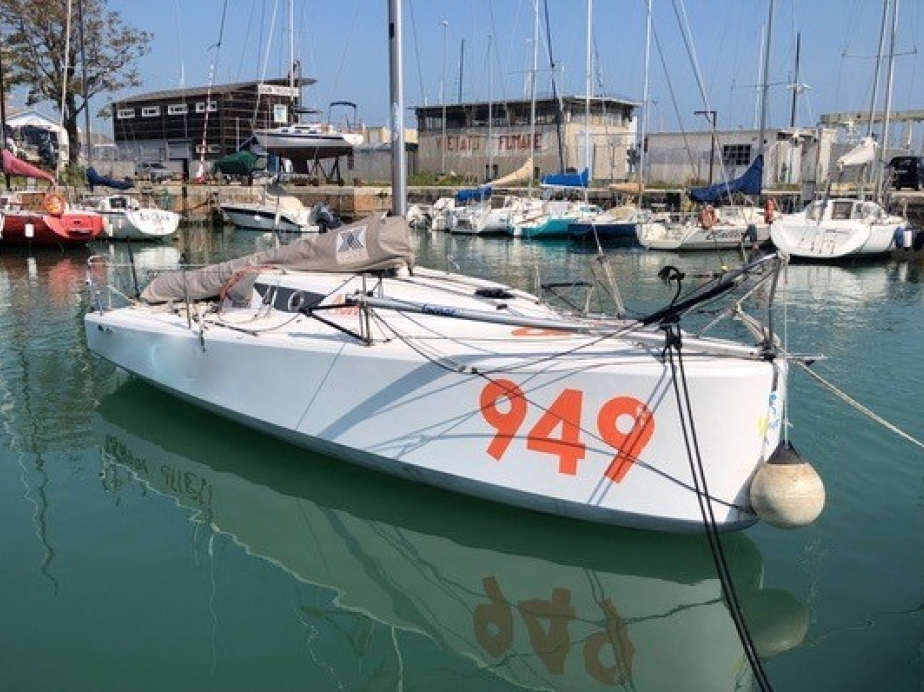

Wevo 6.50 mini class
€57,500
VAT included
- Reference ID 668
- Builder Wevo
- Model Mini 6.50
- Skyron: Oris D’Obaldo
- Location Italy
- L.O.A. (mtr) 6.50
- Beam (mtr) 3.00
- Draft (mtr) 1.60
- Displacement (Kg) 910
- Material Composite
Send to friend
Yacht description.
Wevo 6.5 is designed by architect Oris D’Obaldo and his office Skyron and built by Cima Boats in Grosseto, Italy.
The boat was launched in 8th December 2018 and the owner sailed over 8000 miles with the boat.
About the Wevo 6.5
The Wevo has a round bow, the volume of which lies between that of a Pogo 3 and a Maxi. Everything is designed for absolute weight optimization. The individual parts are manufactured using an infusion process. This makes the structure lighter and at the same time improves its stiffness. She is an innovative boat in shape and materials, ready for ocean sailing in the Mini 6.50 Class
26 mq – Gennaker 37,5 mq – Code 5 79 mq – Spinnaker Maxi 60 mq – Spinnaker medio 4 mq – Storm jib 25 mq – Main sail 19,5 mq – Jib
- Facnor furler fx for the Code0
- Running rigging Gottifredi Maffioli
- Main sail with 3 reef, owner: reasonable/ used condition
- Code 0, owner: reasonable/ used condition
- Solent with 1 reef, owner: reasonable/ used condition
- Medium gennaker with 1 reef, owner in perfect condition
- Code5 in perfect condition
- Storm sail with one reef in perfect condition
- Large gennaker 70 m2, owner: used condition but for training is ok.
Deck and Cockpit
- stoppers Constrictor
- winches Antal
- 4 Solbian solar panels for total 300 watt, 2 panels fo 100watt each one + 2 panel of 50wat each one
- 2 lithium batteries 12V, totalling 200 Ah
- liferaft Iso9650-1 Eurovinil for 4 persons
- all the security equipment for the race Mini class
- 2 bilge pumps
Electronics and Navigational Gear
B&G Hercules 5000
- speed, wind, depth
- Ais transceiver
- Vhf handheld
- remote controller
- vhf bluetooth
- Hand bearing compass
- Engine bracket
- Anchor 6kg alu
The Company offers the details of this vessel in good faith but cannot guarantee or warrant the accuracy of this information nor warrant the condition of the vessel. A buyer should instruct his agents, or his surveyors, to investigate such details as the buyer desires validated. This vessel is offered subject to prior sale, price change, or withdrawal without notice.
Contact Details
- Name Site Broker | Racing-Yachts.com
- Email [email protected]
- Phone 1234567
- Instagram -
Featured Yachts For Sale
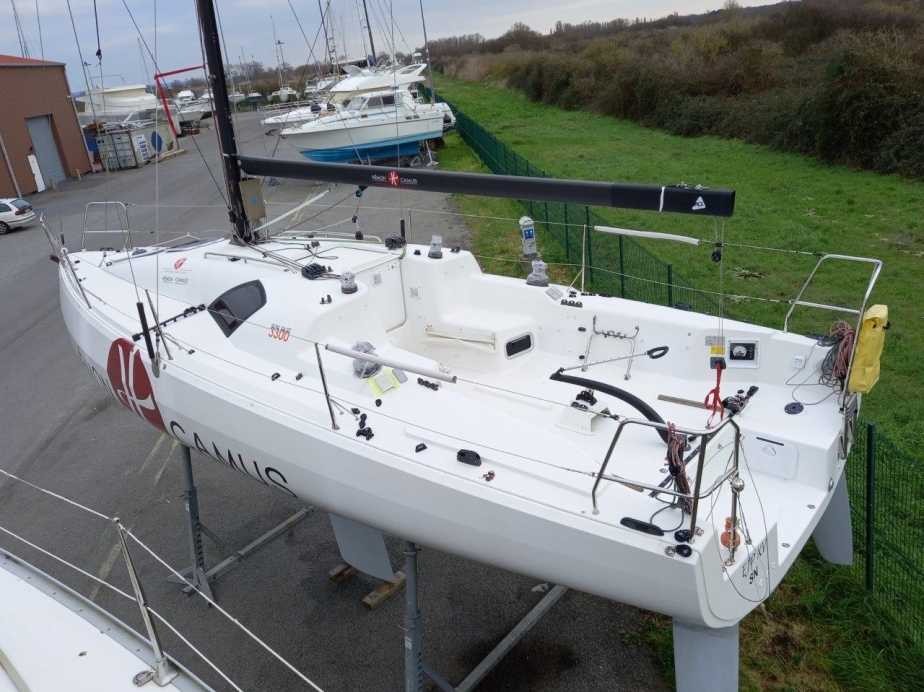
- Displacement (Kg): 3500
- Beam (mtr): 3.40
- L.O.A. (mtr): 10.00 Meters
- Horsepower: 14 hp

- L.O.A. (mtr): 15.20 Meters
- Horsepower: 110 hp
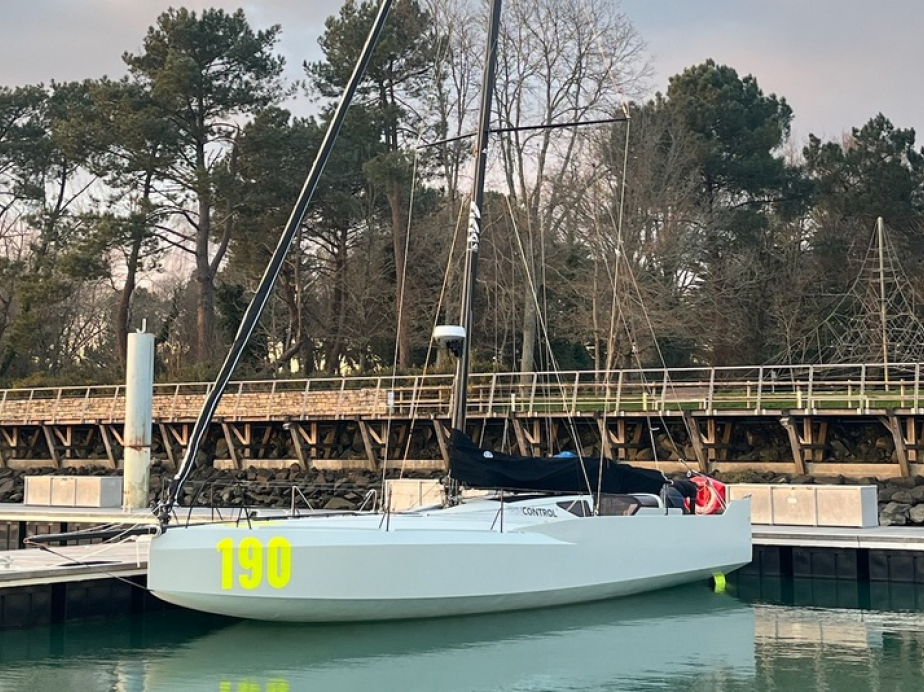
- Displacement (Kg): 4500
- Beam (mtr): 4.50
- L.O.A. (mtr): 12.19 Meters

- AMERICA'S CUP
- CLASSIFIEDS
- NEWSLETTERS
- SUBMIT NEWS

5.6 Mini class land yachts bring rolling starts and large fleets to Worlds
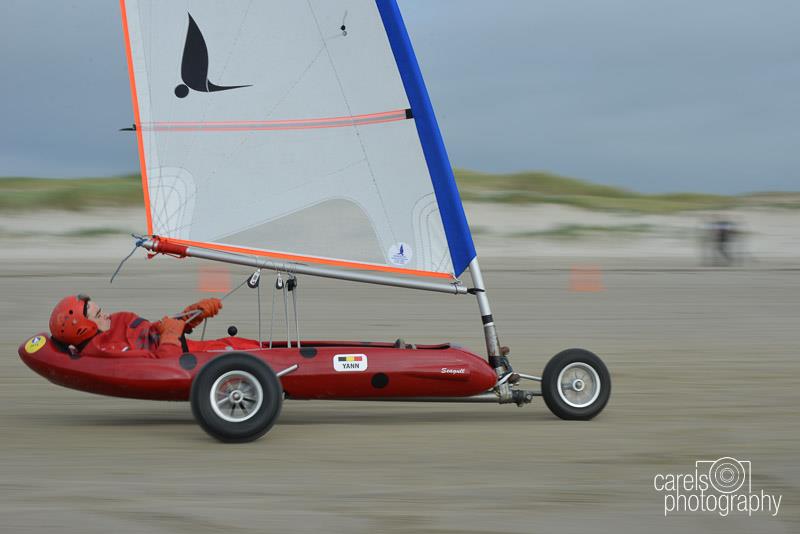
Related Articles
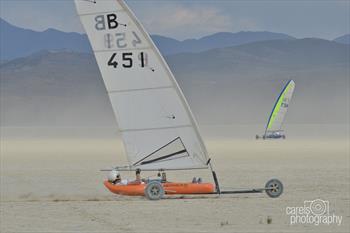
Upcoming Events

Vector 6.5 Mini Racer
- October 5th, 2022
Upon seeing the apparently brand new boat, I immediately took out my cell phone and called a number: “Could this be your new boat?”, I asked the guy at the other end. “Yepp, she is it!”, confirmed the voice of a young man. If I´d see it to make an article, I went on asking. No problem, assured the man and a day later – sunny sky with dramatic autumn clouds – we met in person. The guy is Hendrick Decker, a tall, blond, energetic, always brightly smiling young lad – the prototype of a surfer´s guys, I shall say.
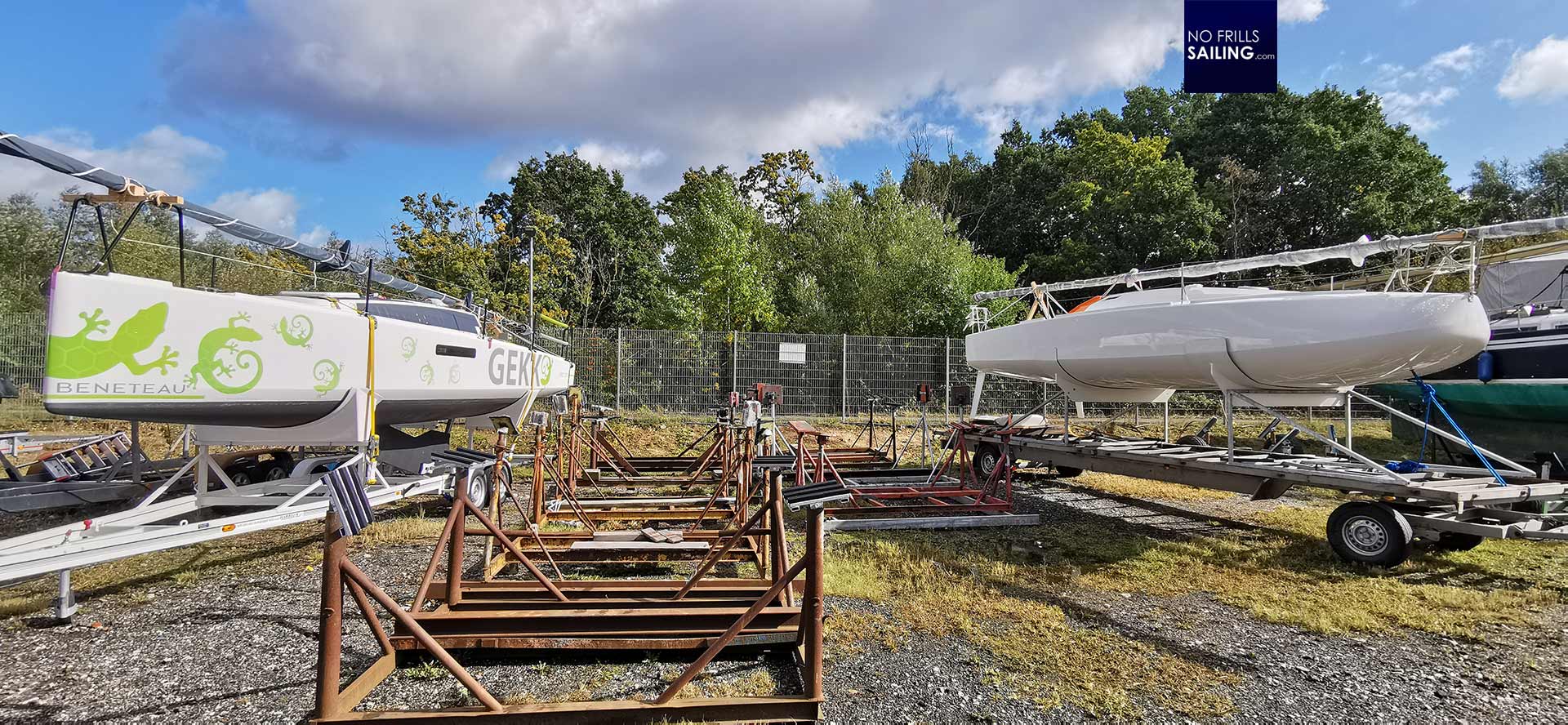
His new boat: A Vector Mini 6.50 racer. Brand new, freshly imported from the yard and parked at the marina , by chance, right next to GEKKO. I was there to fix her on the trailer to make her transport-ready for getting her ack to our yard for completing the last tasks before finally handing her over to her new owners. How lucky am I, have I thought, having this brand new racing boat right next to me. Happy that Hendrick found some time to show me around, I was keen on inspecting how a Classe Mini 6.50 racing boat arrives when newly built.
The Scow-bowed Mini racer
The Vector 6.5 is the latest generation series production Classe Mini 6.50 racer. The boat has been designed by Frenchman Etienne Bertrand in 2017, entering that year´s edition of the Mini Transat race as a prototype, finishing off at an impressive second place. The boat displays latest downwind running optimized hull with an impressive scow bow.
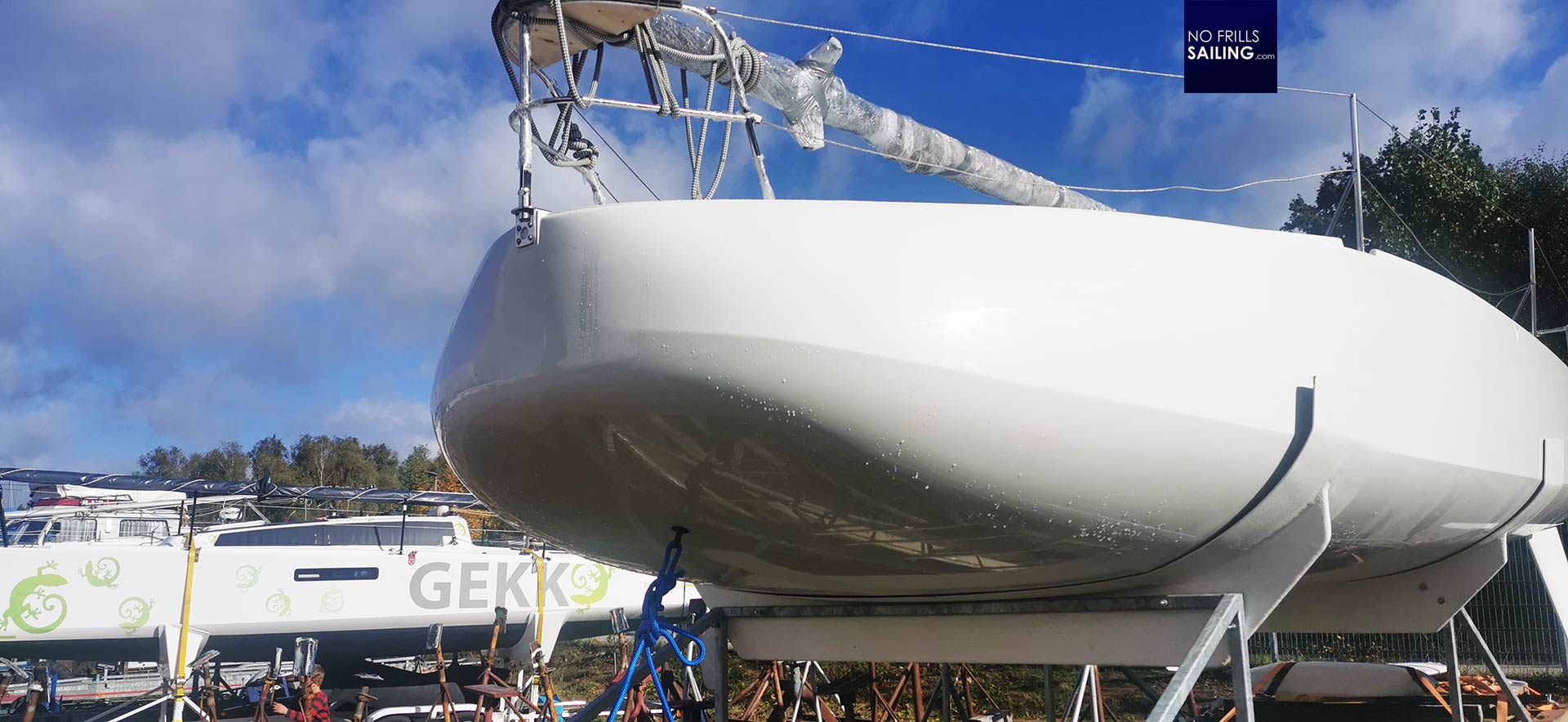
Hendrick smiles brightly as he places a half-emptied bottle of Coce on the trailer: “Yesterday´s regatta celebration went a bit off …”, he smiled half excusatory: “45 knots of wind and a 3 meter wave, it was fun.” Hendrick is a thoroughbred racer. Sailing since he was a small kid, his father´s big cruising boat in a yard´s shed just a few hundred meters away. Hendrick sails races since ever, his old boat, PLAYGIRL, being a used Vector Mini racer, sold months ago: “I am happy to having finally received the new boat”, he reveals: PLAYGIRL 2 is about to be re-located to a shed he rented nearby for finishing.
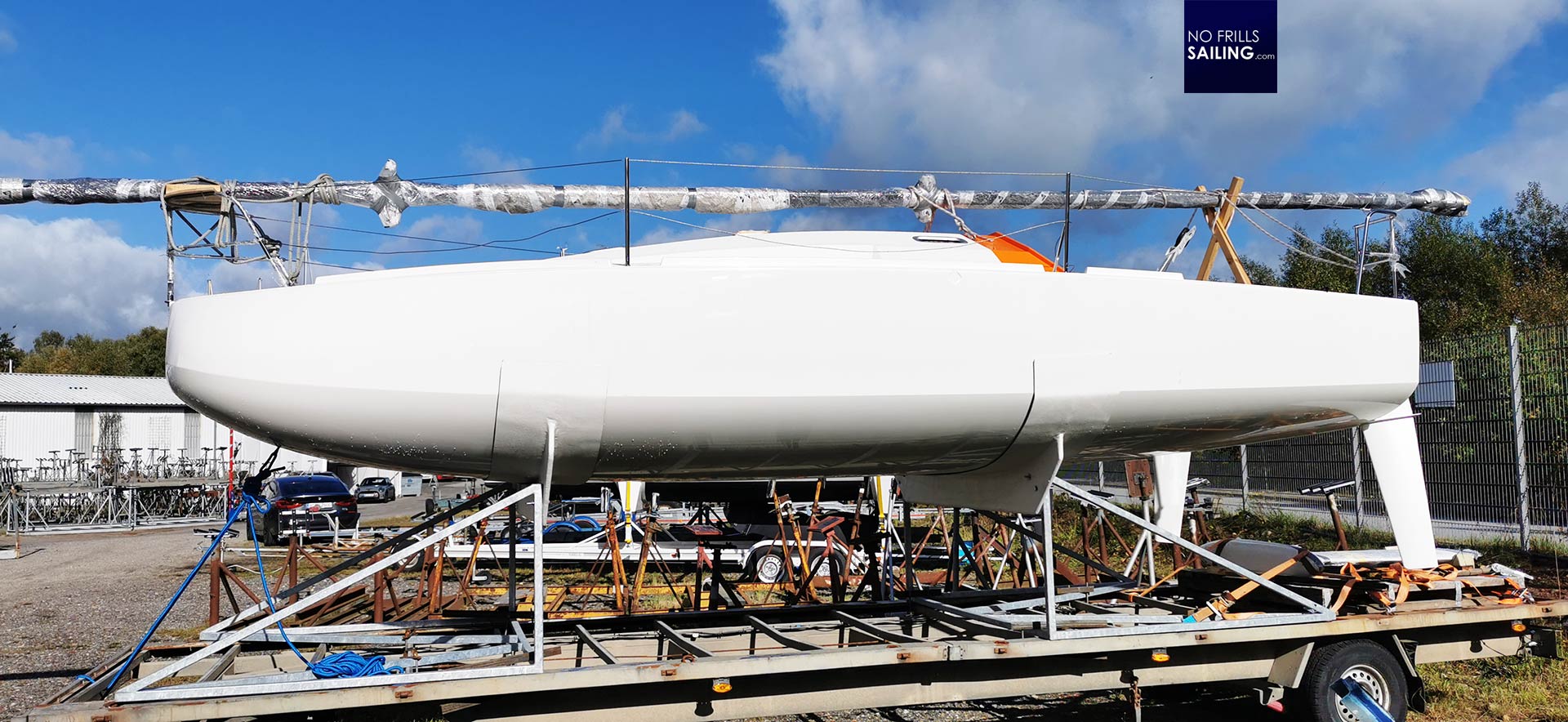
As a Class Mini boat, the box rule of the class dictate measurements and appearance: At 21 feet length the boat must have a minimum freeboard of .75 centimeters and a maximum draft of 2 meters. The rule also dictates, that the mast could not be taller than 12 meters.
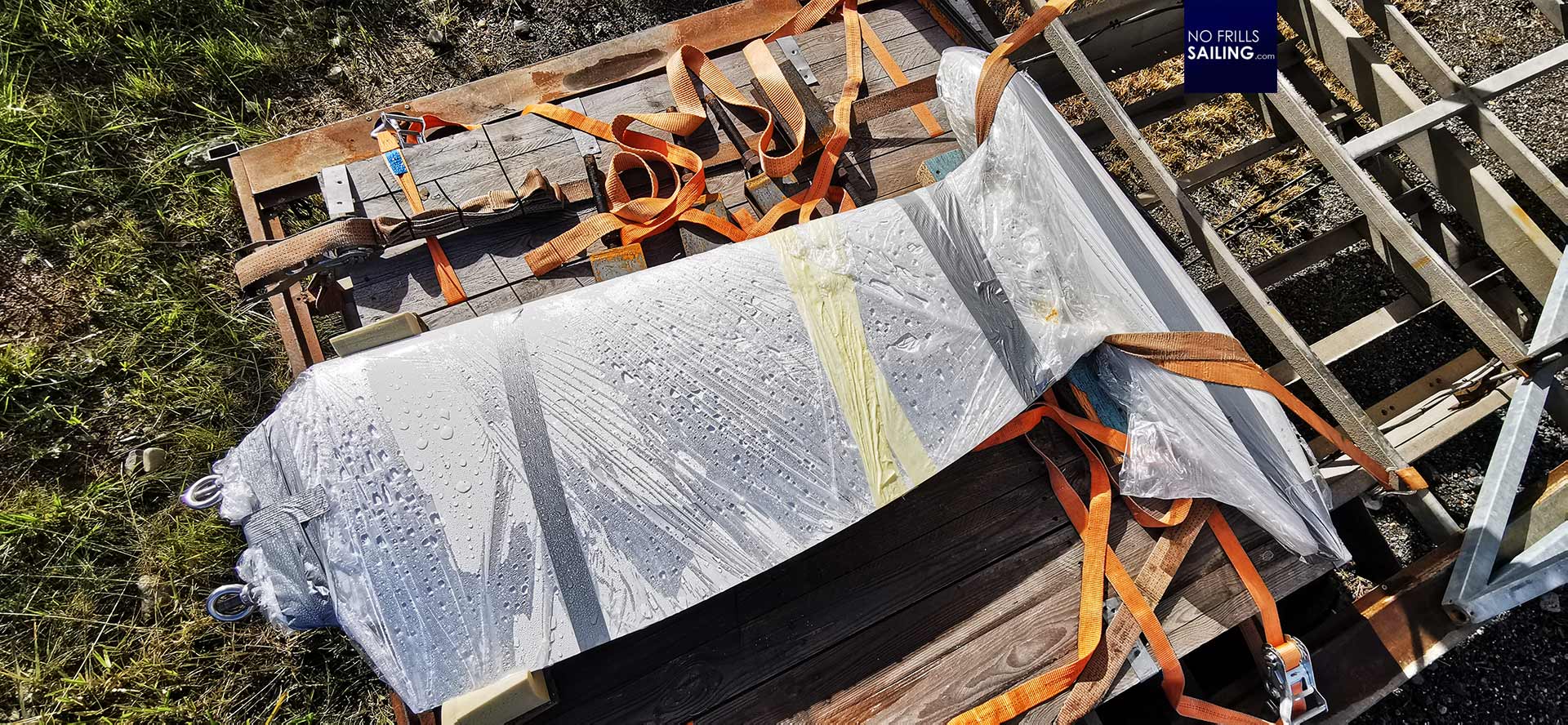
Deep down, still strapped to the improvised trailer, lies the keel. That’s a solid piece of metal: Cast iron fin and a lead T-bulb. Hendrick smiles as I touch the keel: “I am wondering of switching from series boat to prototype”, Hendrick says: “There´s much more possible on these boats, like a canting keel for example.”
Improvements for planning
Nevertheless, even with “only” a series production boat, his new vector 6.5 Mini has some nice improvements over his past boat . He shows a little but interesting detail: The trailing edges of his rudder blades still not “tuned” (like I did on my own boat , he points to a small fin.
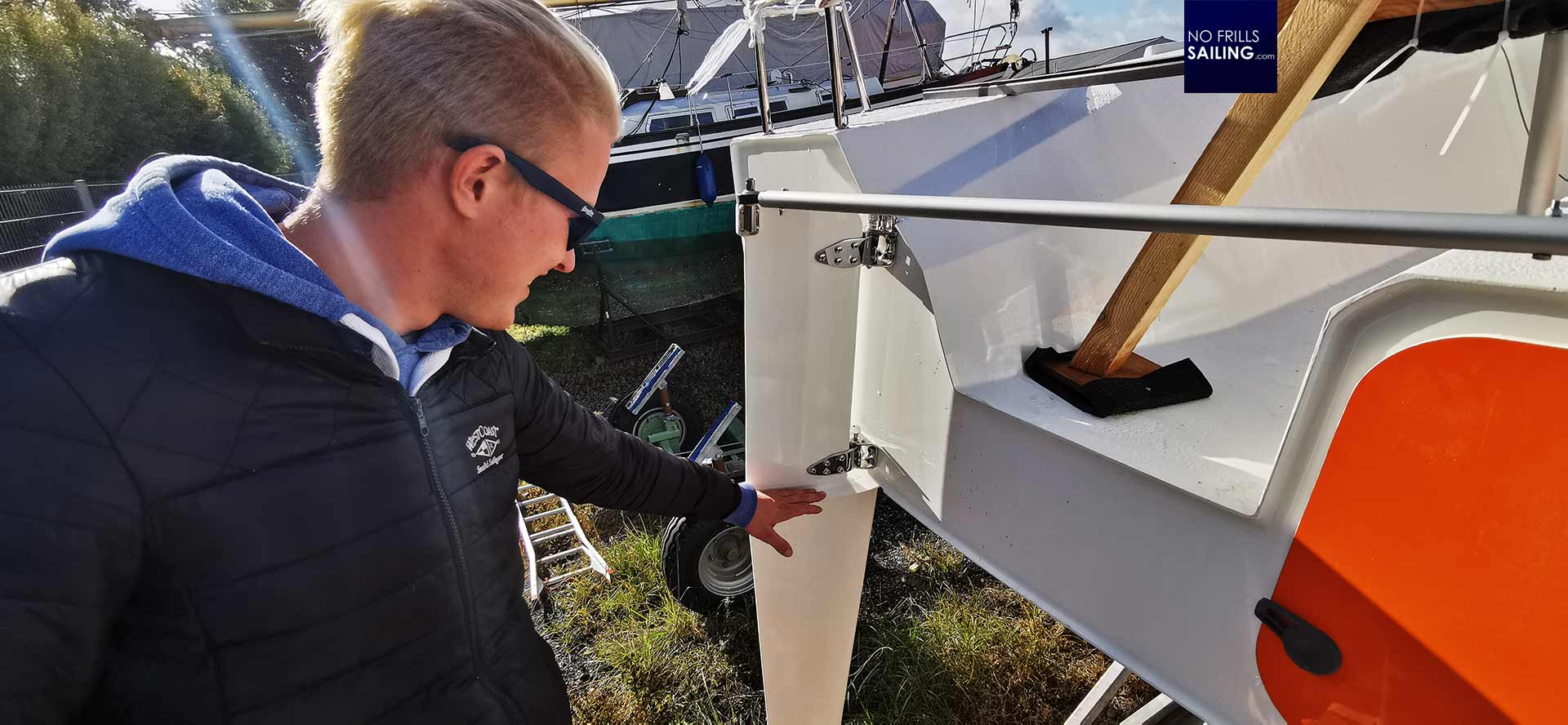
This is new, for example, in this latest version. When planning, it´s the front side of the rudder blade right here where it cuts into the water, where a small wave is created. This wave constantly grabs a firm hold onto the boat´s stern, thus creating some drag that costs speed.
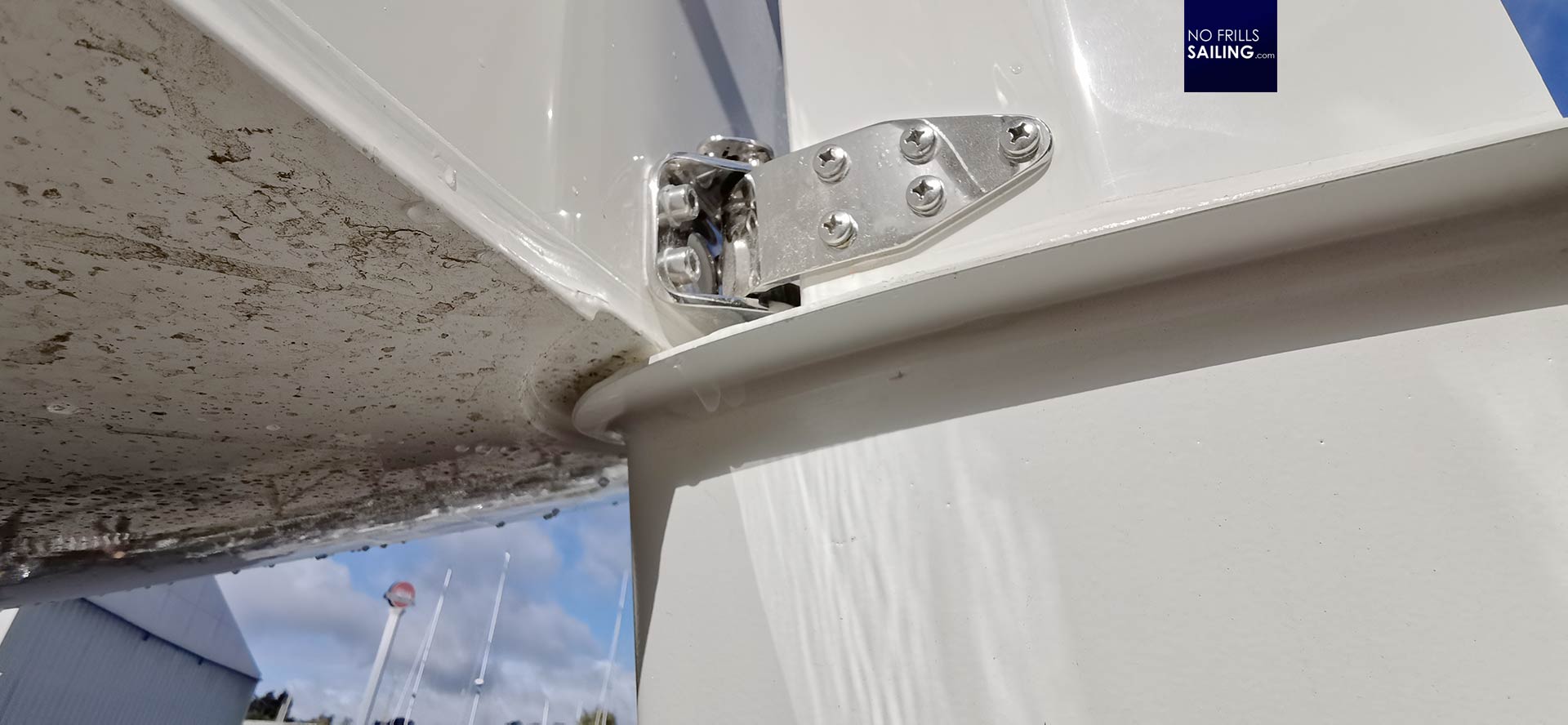
The designer of this boat came up with a small horizontal insert that kind of separates the wet downside of the blades from the stern and is meant to divert the water coming up from the blade to shoot away aft. I find this detail is a great example of what we are talking about here: A serious racing machine meant to wind races. In total, what might be the real net gain of having those small “breaker fins” versus not having them? A hundredth of a knot? But it is the sum of all improvements, every gram spared, every bit of drag reduced, tat makes the difference over hundreds of miles sailed – and hence, the win. Or the loss.
A little big boat
Hendrik climbs on the trailer and into the boat´s cockpit, I follow. The boat is a “Mini” in the closest sense of the word indeed. Six and a half meters is pretty short. Nevertheless, the cockpit itself does not feel all too small, I shall say.
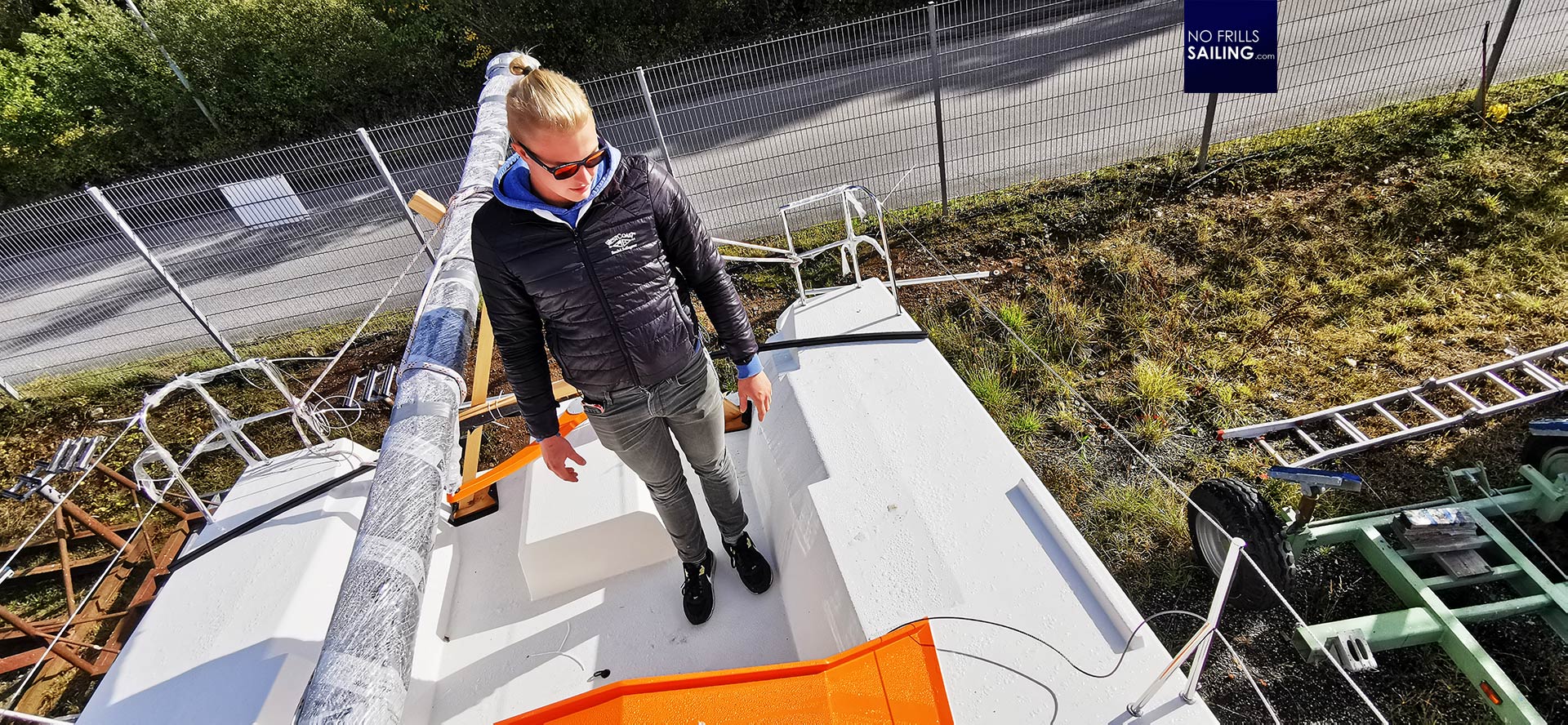
With a width of three meters the Mini is half a meter wider than my old First 27 SE which had a beam of 2.54 m. Even her cockpit felt nice and roomy. I look to the bow and contemplate the enormous area the boat´s deck covers: Since it is a scow bow-boat, it bears much more volume than, let´s say a comparable J-Boat that is much thinner.
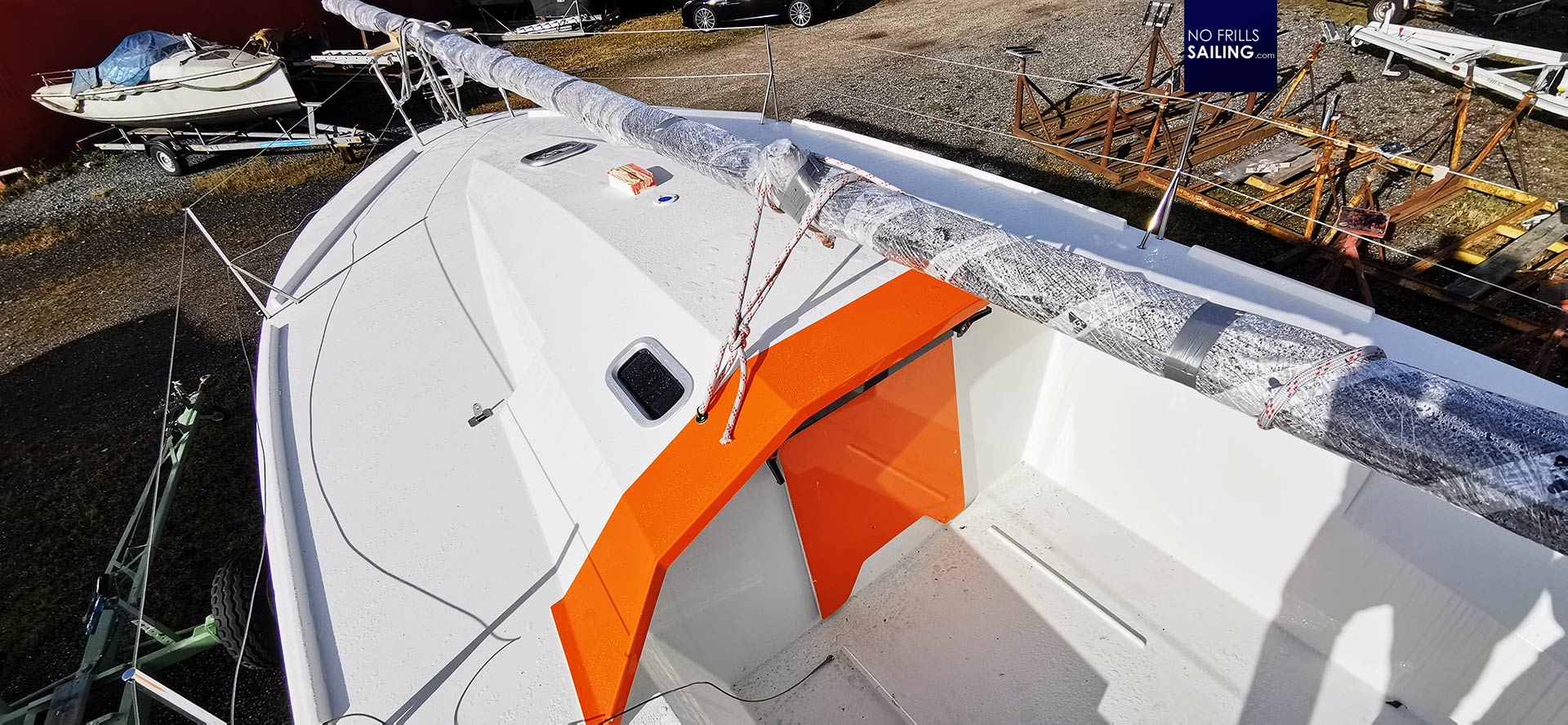
In essence, the Classe Mini-boats is a pure downwind-optimized class. These racing machines are meant to easily take off and start planning mode very early. Upwind sailing capabilities, Hendrik confirms this, are “pretty adventurous”, as he names it. I shall say, these boats are made for reaching points of sail and those alone. Like a giant surf board made to glide above the water.
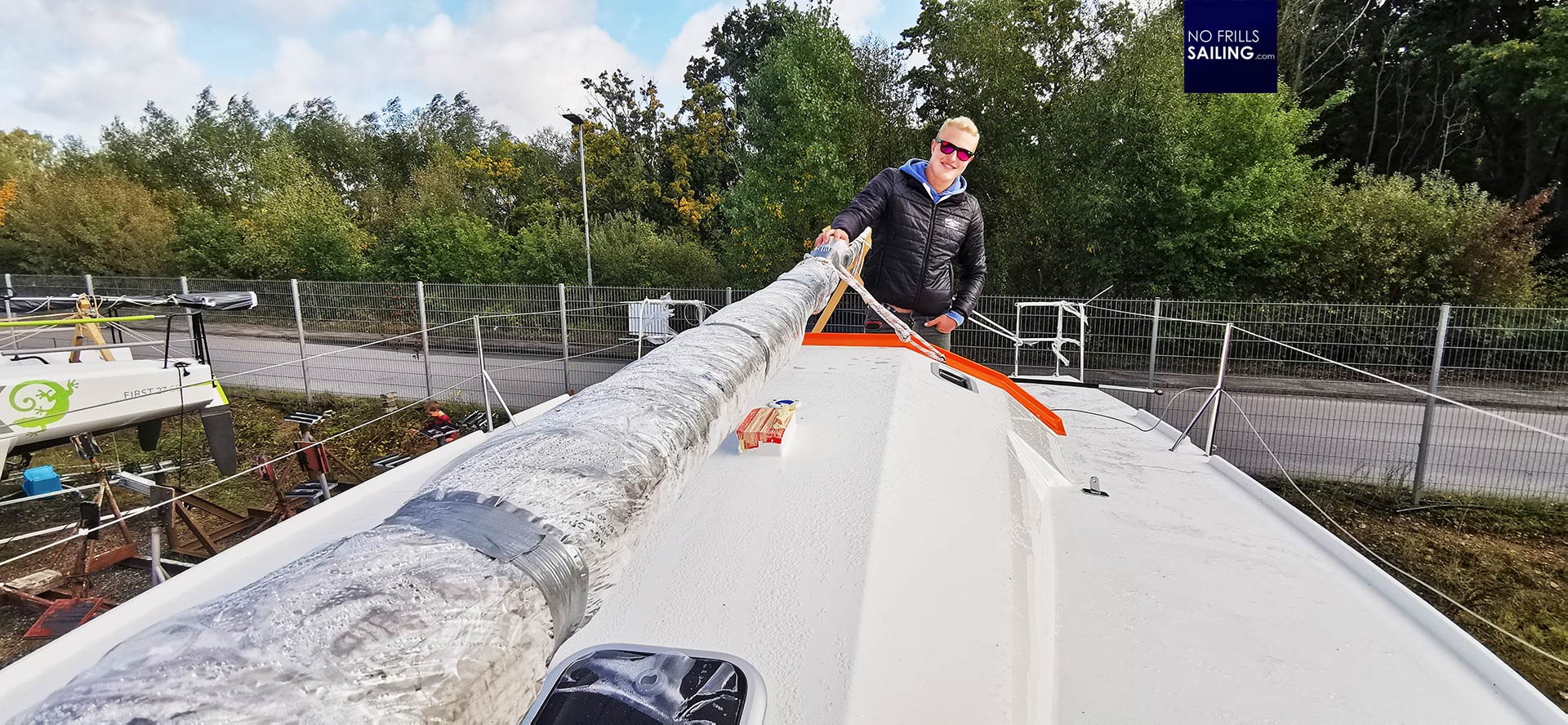
The hull including mast, standing and running rigging, is around 50.000 Euros ex VAT. This is a surprisingly low price, I wonder, since the boat is made with infusion technology and 3D core foam. High tech materials and production methods. Yet, Hendrik needs at least the same budget again to be spent on sails, deck gear and financing his Mini Transat campaign: “I work hard for coming up with all the money, but a sponsor taking on at least a part, naturally, would be great of course!”
Totally costumizeble
And such a future sponsor will get a pretty darn good skipper: Hendrik is a keen regatta sailor and – at least for the Baltic Sea, there is seldom a race he misses. “We will see”, he says and shoots out a winning smile: “There´s plenty of time. I am going to customize the boat to my needs over winter. For that, I´ve rented a shed where the boat will be transferred to.” Hendrik places himself on the port side at the helm.
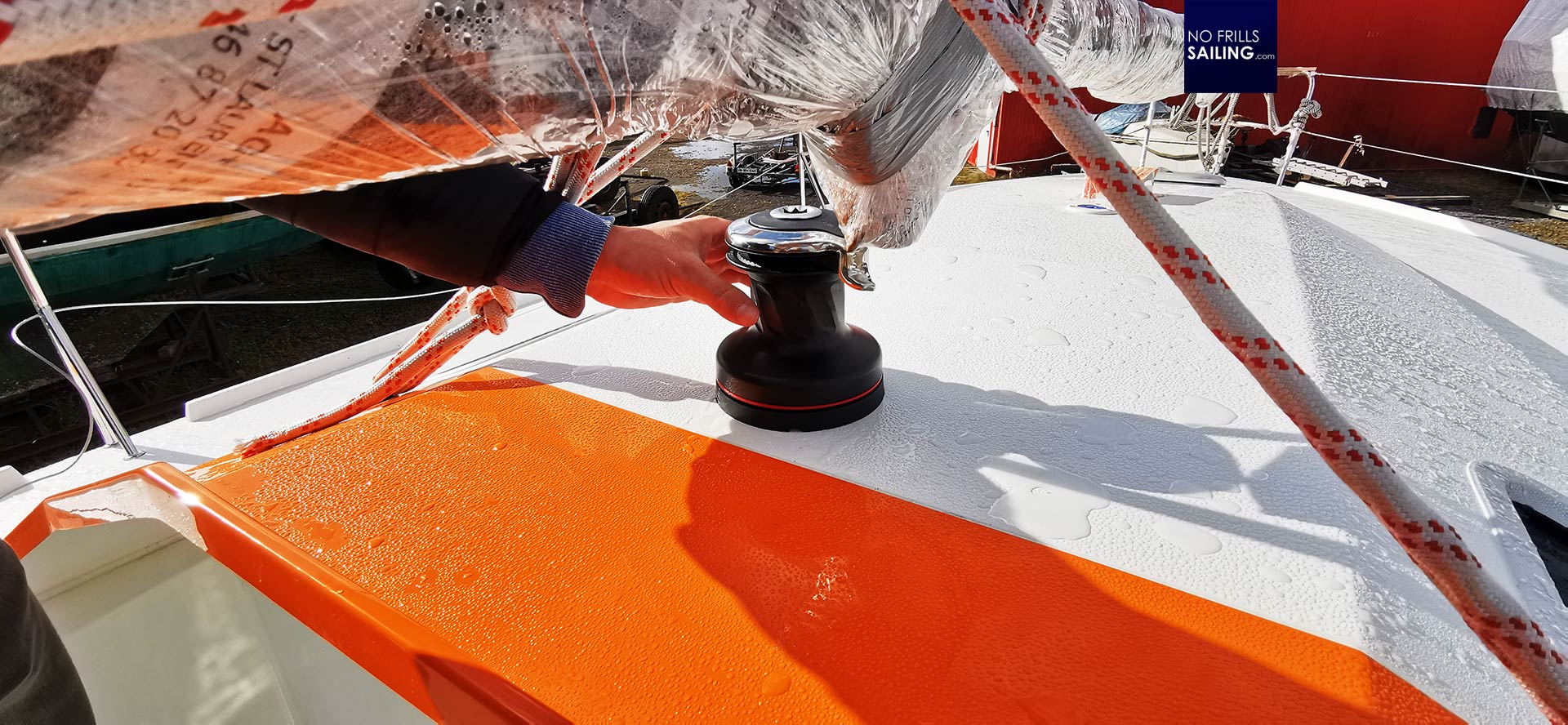
The Vector 6.5 can be bought ”naked”. Skilled boat builders and sailors like Hendrik can now decide where to put the winches, where to put the cleats and all gear. In this, the boat can be tailor-fit to the needs of the skipper´s very own body. Again, how much time can be saved by a winch that does not require to change seating position when working on the lever? A thousandth of a second? Yet, how many times over does a skipper have to fine trim the sails … multiplied by the thousands of miles in a Mini Transat race. A lot of gain.
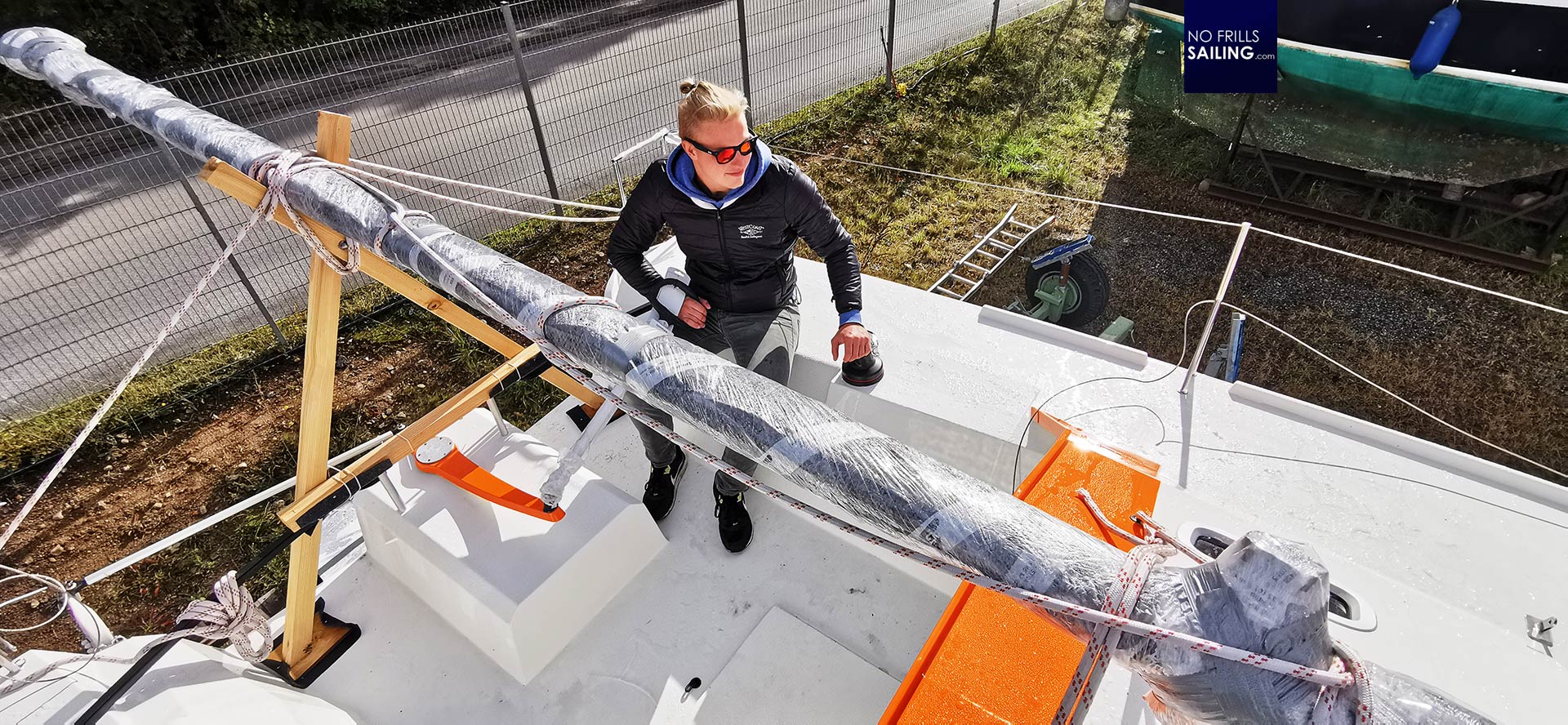
The boat will receive a central winch on the dodger and two Genoa-winches on the coaming. The mainsheet traveler has already been mounted by the yard, but according to the wishes of Hendrik. “On the old boat the traveler was positioned right in front of the entryway down, which was always a hustle having to go around the mainsheet when working the piano, now it´s much better.” Again, these subtle changes adding to the formula of winning a race or not.
Series boat versus prototype
“Still, a prototype would be even cooler”, he says. Why?, I ask: Just having a carbon made boat won´t make so much difference, or will it? “Well, just being admitted into the starting field with a series boat is a gamble. There are much more applicants than places. With a prototype, your starting place is almost safe”, Hendrik says. Secondly, he explains, the carbon-made Mini 6.5 is much light which directly translates into speed.
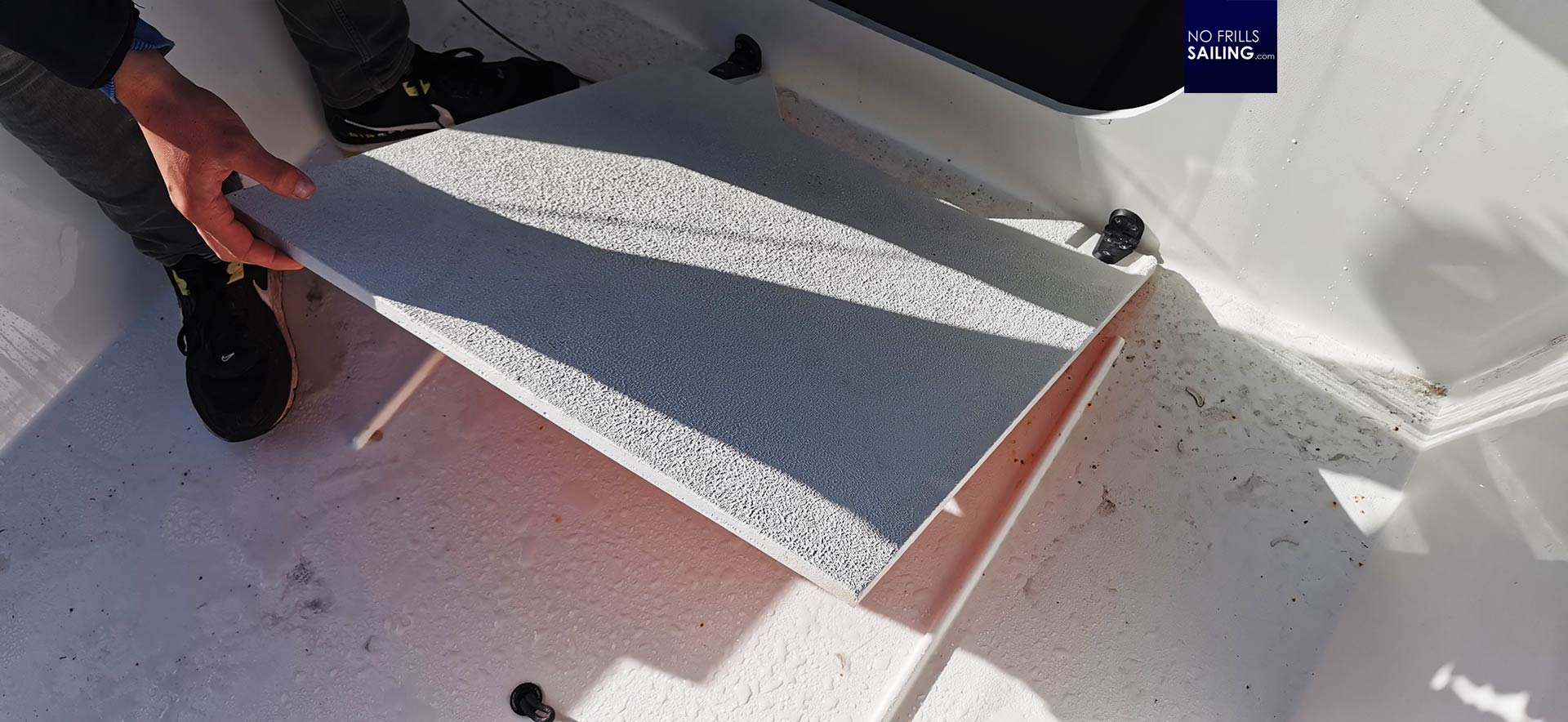
“Plus”, he says with a glow in his eyes, you can play around with many much, much cooler things: “Like you get a taller mast, ergo more sails area. Like the canting keel, which give you more power on the tougher points of sails. Or just take the whole topic of foils: This is something I would find absolutely amazing to have a foiling Mini!” He opens the entry to the boat´s interior and invites me to check it out.
Welcome to the inside
The Vector 6.5 comes with a slightly overhang dodger that also has a mini-wave breaker. “This is also new in regard to the former version. I hope that the amount of spray water in foul weather is at least reduced”, he smiles: I know very well by myself how nasty even the tiny Baltic Sea can get at times …
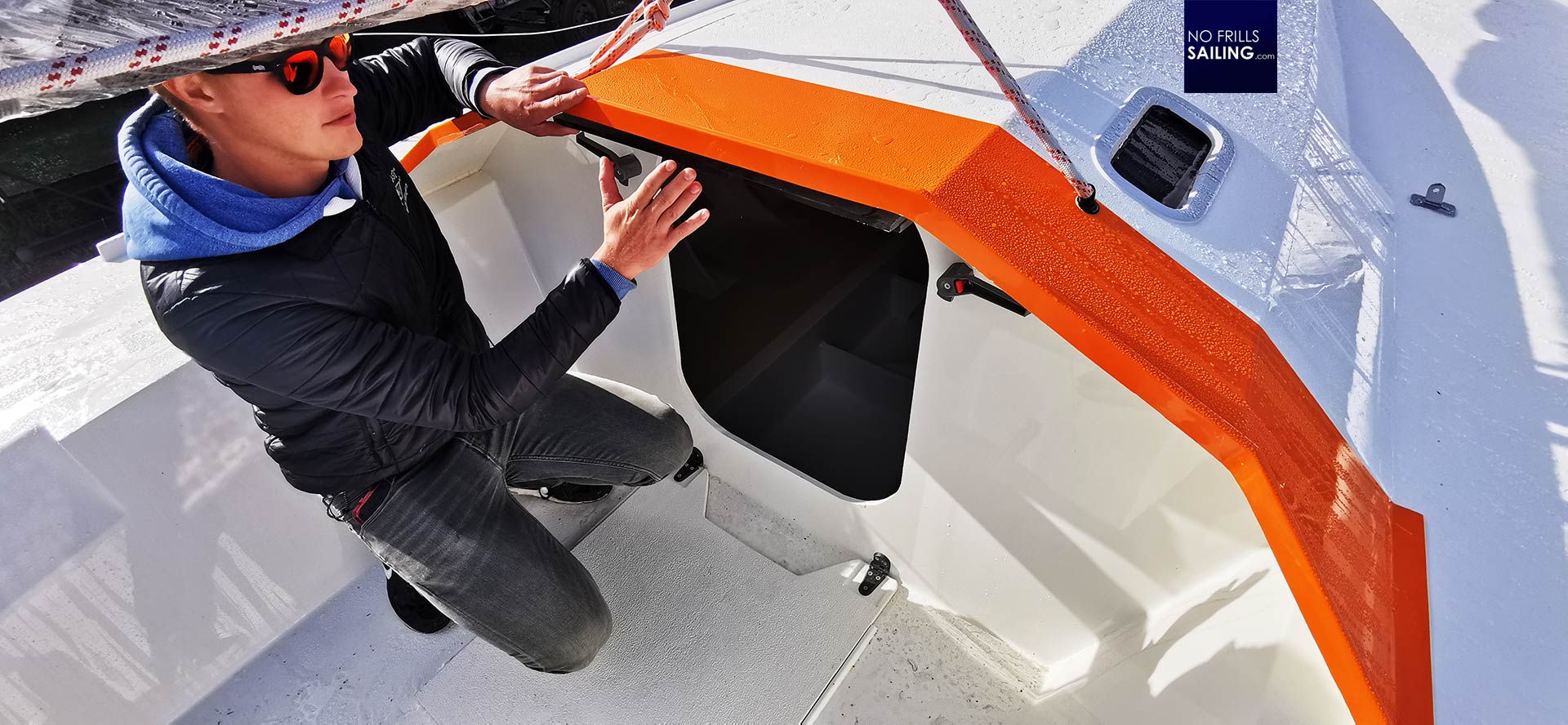
My first look into the inners of the Vector 6.5 is accompanied by a “Wooow!” The boat is just huge! And here I can clearly see what the huge deck area promised: The volume created inside is just amazing. The “saloon”, if one could call it this way, is even bigger than the counterpart on my old First 27 SE. The nice yellow-ish light that shines through the 3D-foam core creates a wonderful atmosphere. No need for any Top Coat-paint.
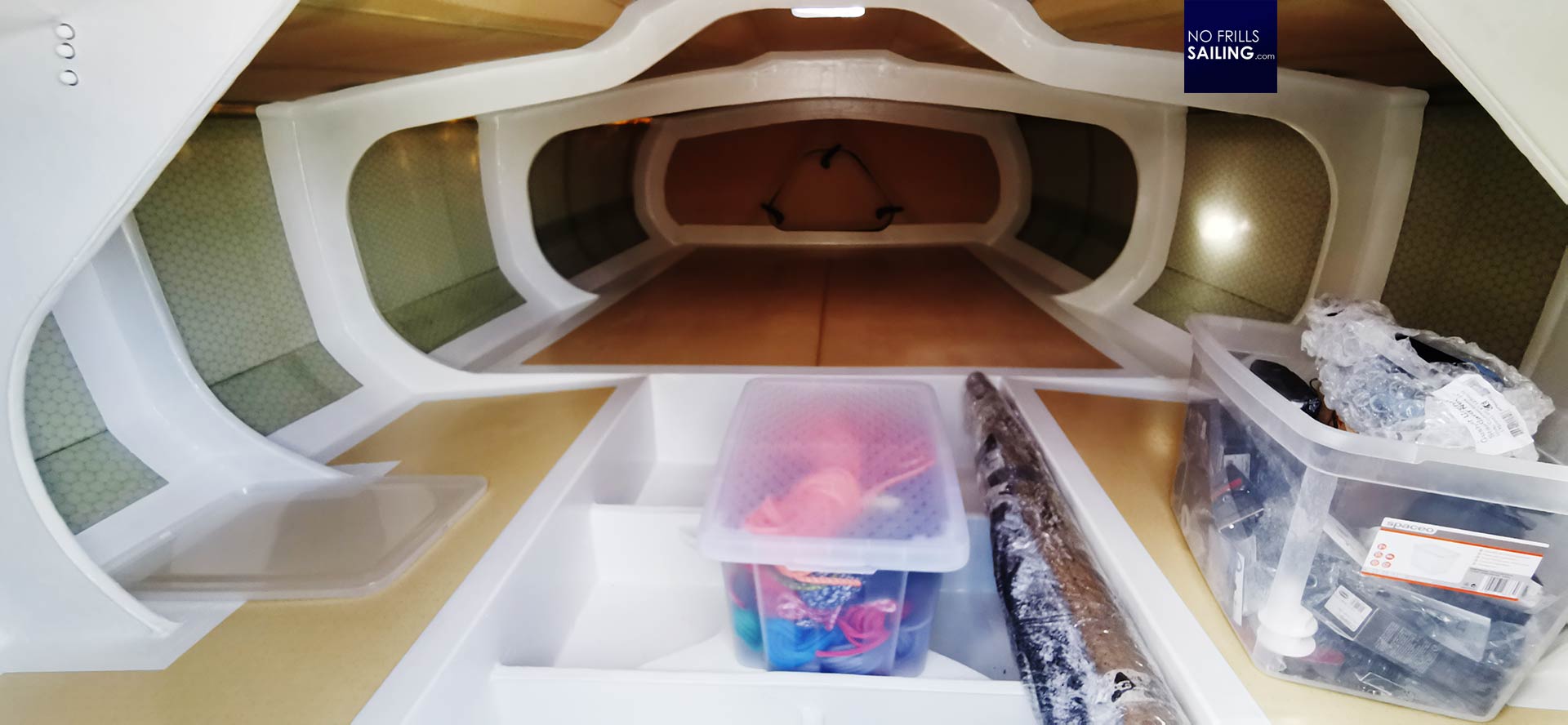
The Vector 6.5 has three watertight foam-filled chambers which, if the boat flips, gets struck by a reef or has a leak . “It shall swim safely on the water even when filled to the brim by the Ocean.”, he smiles. I love the forward compartment of the boat, directly in the bow: The scow-bow allows for huge volume underneath – I´d say any King-size bed in hotel rooms could hardly be offering more area.
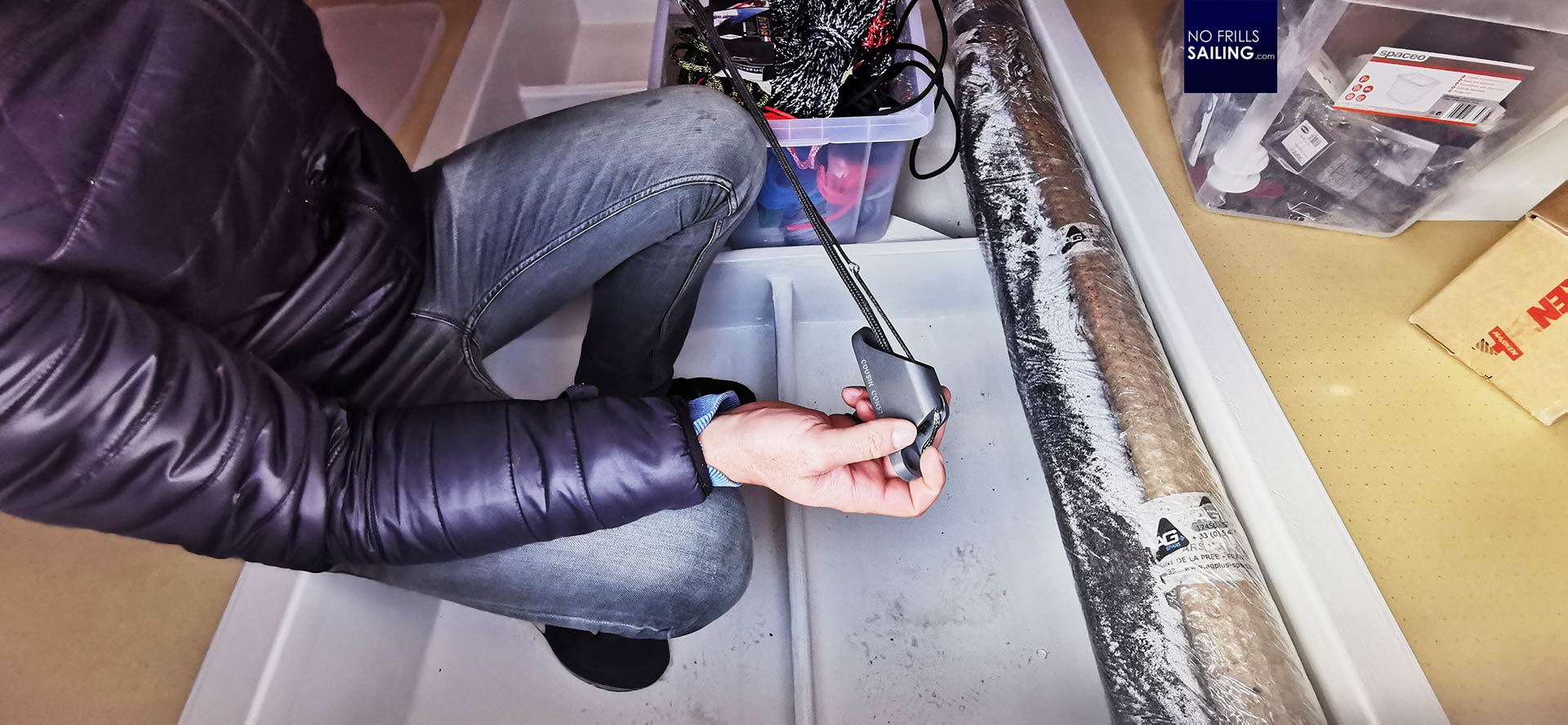
Hendrik shows some of the parts he bought: “I decided to get me some cool stuff, like those constrictor-clutches. They are not only cool looking but also much more kind to the material.” Hi plan is to relocate the boat in the coming weeks to start working over winter: Having her clear and ready to begin his regatta-season in 2023 on spot.
Hendrik´s fundraising campaign
“Still a long way to go”, say Hendrik who is well aware of the current situation: With a looming recession and news of crisis everywhere, inflation like a bad vortex beginning to pull more and more companies in, raising a budget to support his way to the Mini Transat gets even harder. “But I am confident that I can come up with a solution here.” He smiles. There´s no turning back, the boat is bought and for Hendrik it´s not if but how he will hoist his sails next year.
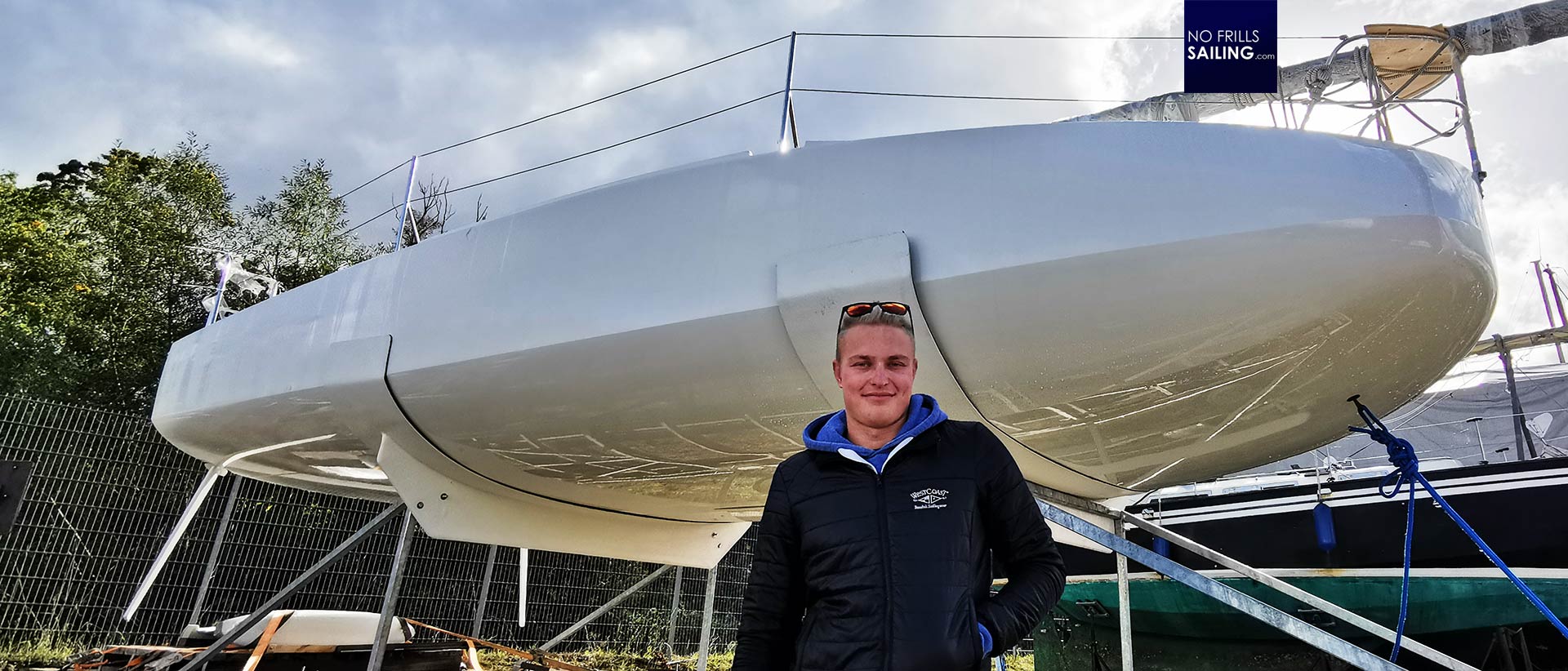
This cool young dedicated man! We say Goodbye and whilst we shake hands Hendrik promises me to take me with him in his brand new PLAYGIRL 2 when ready to sail next spring. Hoping that he will find a way to raise the budget needed to support his dreams of competing at Mini Transat, we part. I drive away and see him climbing onto his boat again in my driving mirror: Surely, he is going to work for an hour or two on his boat to fit some parts. How cool must it be to be young again, I think to myself, and being so close to make a dream come true !
Classe Mini 650: Here is some more fuel for you:
PLAYGIRL : Hendrik Decker´s fast Mini racer
Endgame Mini Transat: Lisa Berger sets full canvas to her dream
Lizzy Foreman on the Mini Transat race

Development class could turn heads at Landsailing Worlds
Published on February 19th, 2014 by Editor -->
During the 2014 Landsailing World Championship, which will be held July 12-19 near Austin, Nevada in the USA, there will be several classes gathering to kick dirt on Smith Creek Playa. However, it could be a relatively new class – the International 5.6 Mini – that turns heads with its simplicity and rapid worldwide growth.
The 5.6 Mini has deceptively uncomplicated design rules that allow a lot of innovation. The most interesting rule concerns the platform of the vehicle. Specifically, when the land yacht is on a flat surface, the lower portion of all tires (presumably three) must fit inside a continuous length of small diameter rope 5.6 meters long. This offers the possibility of yachts with long wheelbases and narrow tracks or just the opposite, and everything in between.
Interestingly, the rules do not specify how the 5.6 Mini races will start. The vehicles are small and maneuverable enough, however, that most 5.6 Mini regattas now feature rolling starts, which is very unusual in land yachting.
Smith Creek Playa is very wide compared to beach race courses. As a result, the race committee can optimize the length and depth of the “starting box” in which the Mini yachts circulate during the timed countdown to the start. “We believe Smith Creek’s size offers us the opportunity to have the best big-fleet starts ever held for the 5.6 Mini Class,” stated Dennis Bassano, President of NALSA, the host organization for the regatta.

The 5.6 Mini rules do not mention sail area, which also is unusual, because virtually all other land yacht classes have sail area restrictions. This non-rule means that heavier sailors can use a larger sail if it suits them and essentially permits unlimited sail area, an exciting prospect.
The rules do not specifically prohibit streamlined bodies and “wheel pants” so these features also are increasingly seen on Minis as innovators figure out ways to reduce aerodynamic drag.
It is the simplicity of the class rules that opens the door for some very interesting vehicles, and it is expected that this development class will put on quite a show at the Landsailing World Championship.
Event website: http://www.nalsa.org/Worlds2014Splash.html
5.6 Mini Yacht Rules – Any assembled land or sand yacht that fits inside a continuous loop of rope 5.6 meter long. – The rope must lie on the ground. The touching part of the tires on the ground must fit inside the rope. – The tire size is maximum 400×8 – The mast must be a circular tube; no wing section – It is recommended that a mini yacht has an effective brake.
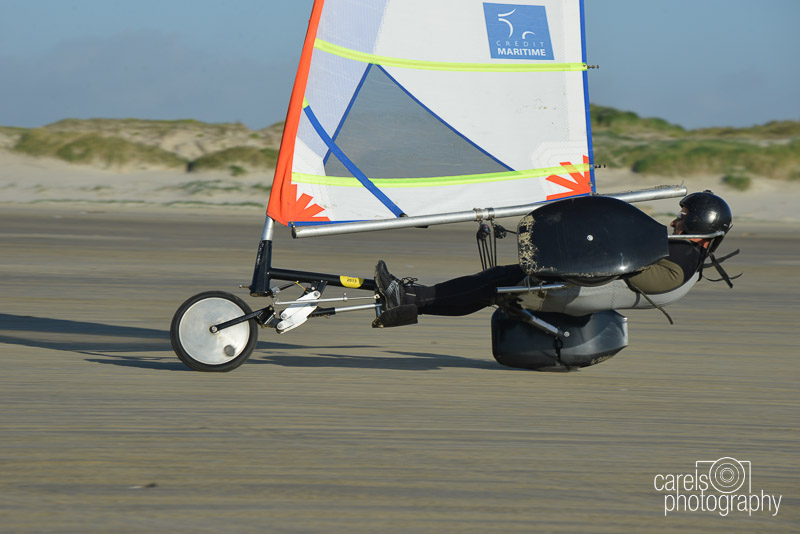
Report by Russ Foster, NALSA Media Coordinator
Landsailing Background Information
About landsailing : A landsailer or landyacht is a wheeled vehicle with a sail for propulsion and is powered solely by wind. Most landsailers use cloth sails to good effect, but wing sails similar to those on the latest America’s Cup catamarans have been used successfully on landsailers since the early 1980s. Most landsailers have a single mainsail and no headsail (jib).
History of Landsailing : For centuries, wheeled sailing vehicles were employed for commerce. In the 19th century, Europeans began constructing landsailers for pleasure and competition. In the U.S., landsailing got its start in the 1960s, and the North American Landsailing Association (NALSA) was incorporated in 1972 by Don Rypinski.
Modern Landsailing : In Europe, landsailing is primarily practiced on beaches. In the United States, most landsailing occurs on dry lake beds in the deserts of the western U.S. and on beaches. There are thousands of landsailors throughout the world, with national and international competitions.
Landsailing Organizations : The International Federation of Sand and Land Yachting (FISLY) is the organization that oversees the sport worldwide, and it comprises some 20 member organizations which represent the individual countries and classes that compete in landsailing races. Founded in Europe in 1962, FISLY is the rule-making body for the sport, and it oversees and sanctions numerous competitions each year.
About NALSA : FISLY’s American affiliate, the North American Landsailing Association (NALSA) provides similar functions for events held in the U.S. NALSA is an all-volunteer non-profit umbrella organization for landsailing clubs throughout the U.S. Its President is Dennis Bassano of Santa Cruz, CA. It was incorporated in 1972 and each year organizes the America’s Landsailing Cup regatta held in the last week of March on Ivanpah dry lake near Primm, NV at the California/Nevada state line off Interstate 15. NALSA has hosted two previous World Championships at Ivanpah in 1990 and 2002. Landsailing Competition : Many landsailing competitions are held throughout the world each year. Every two years, the World Championship (“the Worlds”) has been held in different host countries-Argentina in 2008, Belgium in 2010 and France in 2012. NALSA will host the 2014 championship July 12th through 19th at Smith Creek Playa near the town of Austin in Northern Nevada. The 2014 World Championship will be the final one before the regatta moves to an every-four-year cycle, so the Worlds probably will not return to the U.S. for at least 20 years. This likely will result in a strong turnout of both international and domestic competitors. 2012 World Championships Facts (France) : Countries competing were Argentina, Australia, Belgium, Brazil, Chile, Czech Republic, Denmark, England, France, Germany, Ireland, Italy, Netherlands, Russia, Scotland, Spain, Switzerland, United States. Number of entrants: 350.

Tags: Landsailing , Landsailing World Championship
Related Posts

Dirt sailing: From runners to wheels →
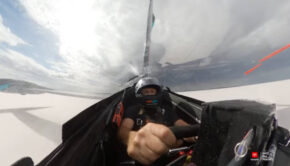
VIDEO: Fast got faster →
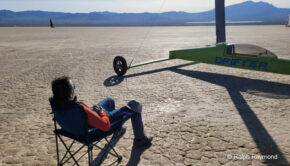
It’s different in the dirt →
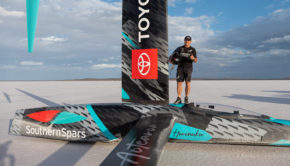
Mission Accomplished: New speed record →
© 2024 Scuttlebutt Sailing News. Inbox Communications, Inc. All Rights Reserved. made by VSSL Agency .
- Privacy Statement
- Advertise With Us
Get Your Sailing News Fix!
Your download by email.
- Your Name...
- Your Email... *
- Email This field is for validation purposes and should be left unchanged.


- AMERICA'S CUP
- CLASSIFIEDS
- NEWSLETTERS
- SUBMIT NEWS

5.6 Mini class land yachts in action

@media screen and (min-width: 70em){.css-1c47y9x{color:var(--chakra-colors-blue\.brand);}} Mini 6.50 buy/sell second hands, ads and prices
The Mini 6.50 is the smallest ocean racing boat. Small but sturdy, the Mini 6.50 regularly crosses the Atlantic.
It is a boat to learn and perform in double and single-handed sailing. It is the boat of the famous Mini Transat, a race on which almost all the greatest sailors used their oilskins at the beginning.
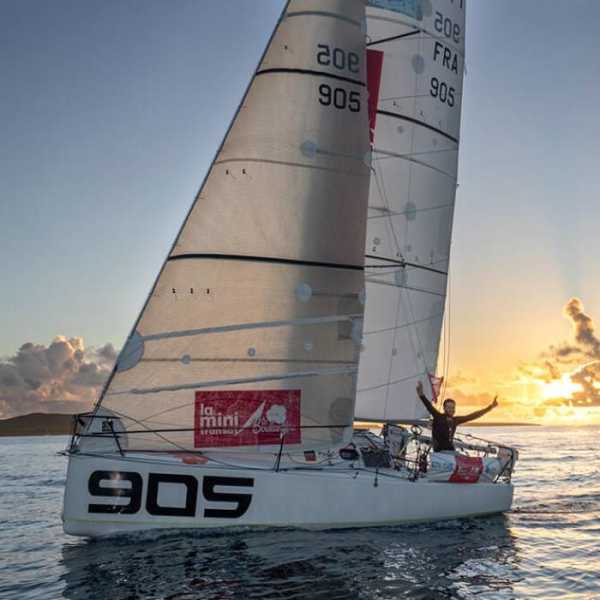
the last Mini 6.50 ads at the best price

Mini 6.50 Autre marque for sale in La Trinité-sur-Mer

Mini 6.50 Autre marque for sale in Roscoff
Mini 6.50 presentation
The model Mini 6.50 has 2 differents versions : Mini 6.50 Proto , Mini 6.50 Série .
Mini 6.50, the smallest ocean racing boat
The Mini 6.50 was born in England in 1977 when for the first time sailors competed in a transatlantic race on the smallest ocean racing boats designed up to that time. The Mini 6.50 has become more and more French from year to year and the English cradle saw the activity settle and make its nest on the French Atlantic coast. Top-level sailors have adopted this striking little boat and have made the Mini the first step in ocean racing careers.
Mini 650: small boat, great performance
This little one, whose construction rules (gauge) are quite free, has seen a lot of architectural experimentation. The mini 6.50 series is often referred to as "the laboratory of ocean racing", as the small size of the boats makes it possible to test innovations at a lower cost and more quickly.
The Mini has therefore been equipped with the main innovations of ocean racing keelboats: pendulum keel, pendulum rigging, wing mast, thick sails and foils for the most modern boats.
The Mini, because of all these qualities, attracted many of the big names in ocean racing and this striking little boat accompanied their debut. The expression that best describes the mini as an offshore school is the phrase "put your mini first", which suggests that every offshore sailor should if possible (or even imperatively) start with a few years at the helm of a 6.50 mini.
The Mini Transat 6.50 the big event of the mini calendar
The mini class offers a rich calendar of many regattas in the Atlantic and Mediterranean, often solo, sometimes double-handed (like the Mini Fast Net for example). But the big meeting point for the mini sailors is the mini transat. A race which takes place every 2 years in autumn and which links the Atlantic coast (Les Sables d'Olonne for the next edition) to the Caribbean (in Guadeloupe as for the Route du Rhum for the 2021 edition).
1 model but a lot of Minis
Since its creation, the mini has evolved a lot. The class is currently divided into 2 distinct architectural and building rules. The Mini of series and the Mini prototype. The mini of series which have rather strict rules of construction and must use simpler and less expensive techniques and materials. In addition, series boats must exist in a certain number of examples to be precisely series boats. The most well known series models are the Pogo of the Structures shipyard, the current Pogo is in version 3. The prototypes have much freer rules that allow architects to express their creativity with few limits, whether it is about construction techniques, appendages, materials or sail surfaces.
These two groups of boats, the mini 6.50 prototypes and the mini 6.50 production boats, race together but the sailors have separate rankings: the prototypes logically have much better performance.
Second-hand Mini 6.50 market
Nearly 1000 boats have been produced since the end of the 1970s. Few very old boats are still sailing but there are on the globe. It is therefore easy to find second-hand Mini 6.50 boats for all programmes and budgets. The floor price of these second-hand boats is 15,000€, modern boats can cost up to 100,000€ for recent, high-performance and well-equipped boats.
Some figures of the Mini 6.50 offshore racing yacht :
Min price :
Max price :
Average price :
Median price :
Available boats :
Launch year :
Used Mini 6.50 price table
| Advert title | Builder | Year | Price |
|---|---|---|---|
|
| - | 2014 | 47000€ |
| - | 2006 | 29500€ |

Forums > Land Yacht Sailing > > General
Us 5.6 miniyacht association rule change, ">general ">sail making ">construction ">blokarts ">events & competition.
lachlan3556

VIC, 1066 posts
From what I've read this is 180 degrees from what FISLY were contemplating...should be interesting viewing. I won't mention the positives of such a decision, though there are a few. Do you think this will adversely affect sailors entering the sport who wish to race but can't afford (time/money/knowledge/time/etc) a 'high-end' 5.6mini landyacht?

WA, 1244 posts

SA, 2865 posts
Creating a TRUE international class for any sport is a chance that doesn’t come up often, it’s only happened a few of times in sports. Motor racing, cycling, and yachting, It’s there for the sport of land sailing worldwide at the moment with the mini 5.6 rule. It needs to be done with a long term view of a sport rather than from a selfish personal biased view from a particular person or country. FISLY have done an amazing job of formulating the first true world wide class of MINI 5.6 yet some people trying to manipulate the rules for their own personal reasons….why? One of the reasons the sport has NOT flourished worldwide is there is NO flow through from beginners to top level competition, motorsport is a wonderful example of a well structured sport. The MINI 5.6 is there to be an introduction to the sport for newcomers, often totally inexperienced women and children and on small sailing sites. Then moving on to more advanced race classes. If groups create a fragmented versions of a class they undermine the ENTIRE sport not just that class. This is what has happened in past with VERY poor results. The proposed specs for the US 5.6 Mini is just plain stupid ….. where are the newcomers in the US going to come into the sport? What they will enter is full on ‘no restriction’ class that will cost an arm and leg. Some of the high tech materials have and will be used just to ‘win’ in the class but at what cost….. All right for some with VERY selfish and personal reasons. Please lets just have ONE Mini 5.6 class worldwide and promote the sport for all..
Burt, If you want to create a FREE design class call it that or some other thing else, be creative with what your group is or wants to be ... BUT do NOT call it a 'MINI' or have '5.6' in the name as this confuses newcomers. Do the right thing for the sport and land sailers worldwide.
Gizmo makes a good point and is what FISLY is expecting to do (I believe) - create a group for those wishing to go faster (ie: 5.6mini 'open' and 'restricted'). Seems simple enough to me to work with, at least until we try and decide what features fit the 'restricted' or 'open' classifications. This said, the USA situation is a little different to the rest of the world. I think they have an entry class, this being the Manta. However, the USA may find it hard to attract European landsailors who enjoy the current 5.6mini (or future 5.6mini R class).

WA, 5921 posts
unusual for me to say the the US rules are a tad to simple , but I think the wheel restrictions should have remained. other than that Im fine with it . the problem that I see is that all the rules that get proposed are basically there to hold back those that re developing the class and advancing the sport. by resticting them you are killing the sport whilst accusing them of killing the sport . the people you want to simply buy a yacht and expect to win are never going to be happy. i would suggest they buy a blokart and go blokarting. that would solve all their issues. in terms of cost. the fastest,and most advanced minis around are all built by people who have taught themselves the skills required to design , build and race the machines. they are generally the most giving of knowledge and time to encourage and teach others


WA, 261 posts
I agree with Landyacht. By teaching others the knowledge and skills as well as encouraging helps the sport progress. The fast guys want others to improve, its pointless designing and developing a fast mini if you have no competition. Designing and building land yachts is an investment in time. Most are made from recycled materials anyway. I think the most exotic material is some carbon fibre that I put on my seat. Nothing too high tech about that. Mini yachts aren't expensive compared to a fully decked out performance blokart. If you have to pay someone else to build YOUR yacht it can be expensive. Designing and building is part of the fun (its not windy every weekend). I love the mini class more than class 5 because I have the freedom to express and explore my ideas.
The US miniyacht association has been exstablished for the last 11 years and we have endured the negative responses to the mini class which has changed since the advent of the FISLY 5.6 mini class. We support FISLY! They have done a great job and they will continue to do so. The US 5.6 mini class is a " US class only!" not ment to be an international class, or to set a precedence for any other country. We will continue to support FISLY's 5.6 mini class. I understand that in 2017 there may be some rule changes to try and bring back the original intent of the class as an avenue for all ages and skill levels in a safer, more EQUAL racing venue. These pending changes could effect all 5.6 mini yachts with bodies or body types, which would exclude those yachts. We feel there needs to be a place for all pilots and their yachts to race. So, like the UK, we in the US, will support the FISLY 5.6 mini class. And the unlimited US 5.6 mini class. Burt/US306

SA, 32 posts
here we go again another person wanting to do what they want and the rest of the world can go jump seen it before i shake my head
Well I guess I will throw my hat into the ring. I have been landsailing for the last 8 years or so and have enjoyed it since day 1. My rules are, find a large flat spot, wind blowing, setup yacht, go sailing!! No rules, lots of fun. To many rules ruins any novis sport for anyone, just when you think you got it right, they change the rules. Use the KISS theory, they had a good plan for the 5.6 mini class when it started, Leave it alone. Not many people can afford a 3,000 dollar mini yacht.
I guess there are two issues at play here also. Racing vs. novice entry into the sport, do novice sailors really need to be competitive racing? Would they ever be regardless of yacht? Windcrazy has a point too, anyone can still rock up and sail. And I would argue for any club/group to make sure this can happen. I doubt anyone would argue that you can be competitive without devoting considerable resources, practice likely being the number one. But I wonder why the current FISLY 5.6mini rules, to which people have already been building to with varied and exotic results, has been deemed too restrictive?
Test pilot 1

WA, 1430 posts

WA, 34 posts

WA, 215 posts
I second the point that Chook made Your new 5.6 definition includes kite buggies which in many cases will blow minis out of the water because they can carry so much more sail. How about considering the consequences before jumping in the deep end.
Select to expand quote Sylk said.. I second the point that Chook made Your new 5.6 definition includes kite buggies which in many cases will blow minis out of the water because they can carry so much more sail. How about considering the consequences before jumping in the deep end. wouldnt be very big kite buggies. how about build one that fits in the rope and we try it. you current axle would be rather wide perhaps
Select to expand quote lachlan3556 said.. Gizmo makes a good point and is what FISLY is expecting to do (I believe) - create a group for those wishing to go faster (ie: 5.6mini 'open' and 'restricted'). Seems simple enough to me to work with, at least until we try and decide what features fit the 'restricted' or 'open' classifications. This said, the USA situation is a little different to the rest of the world. I think they have an entry class, this being the Manta. However, the USA may find it hard to attract European landsailors who enjoy the current 5.6mini (or future 5.6mini R class). Questions: Who are the rule makers in FISLY? Are the rule changes that are being considered published anywhere? Has FISLY requested input from interested people or is this purely a top down process? All the information on FISLY rules that I could find on the internet was dated.
http://www.fisly.org/index.php?id=1 Lots of info if you go exploring the FISLY website.
Gizmo said.. http://www.fisly.org/index.php?id=1 Lots of info if you go exploring the FISLY website. Thanks for your reply, Gizmo, but I had already looked at the FISLY site. The latest information on mini yacht rules is dated 2012. There is nothing on proposed rule changes or on a rules committee or how rule changes occur within FISLY. Perhaps I just missed it?
When the mini 5.6 rules came in they were locked in for a period of 4 years to stop the constant changing of regulations, by doing so it has established some consistency. So I doubt if there were to be changes in the future they would only be minor. Unfortunately the U.S. has tried to modify the rules to suit their own needs limiting the US yachts in international events and international yachts in US events, why people would go down that path is beyond me. One of the reasons the Mini 5.6 rule came in was to establish a truly International yacht class. If you were after more specific details about FISLY / rule changes etc. I suggest that you contact them directly rather than use a forum often based around speculation.
Select to expand quote I Select to expand quote Gizmo said.. When the mini 5.6 rules came in they were locked in for a period of 4 years to stop the constant changing of regulations, by doing so it has established some consistency. So I doubt if there were to be changes in the future they would only be minor. Unfortunately the U.S. has tried to modify the rules to suit their own needs limiting the US yachts in international events and international yachts in US events, why people would go down that path is beyond me. One of the reasons the Mini 5.6 rule came in was to establish a truly International yacht class. If you were after more specific details about FISLY / rule changes etc. I suggest that you contact them directly rather than use a forum often based around speculation. Thanks again, Gizmo. The 4 year period appears to end next year and, based on what Lachlan3556 posted above, it appeared that discussions of rules were already underway - somewhere by someone. I was just trying to find out what is being discussed. I have no problems with the current International mini yacht specs. I do have some concerns about how the races are run, in particular, about the flying start for a race of more than 40 minis with no effective brakes, like last year at Smith Creek. Although I like the idea of a flying start for sailboats going ~6 - 10 knots, it doesn't seem very safe for a large number of minis going much faster.
I would have thought that actual localised race details are more of concern of the local site club / group rather than the International Sport Governing Body. Who were the site / race organisers at Smith Creek? Who devised the starting setup at that event, was it NALSA or FISLY or someone else? I have to agree moving starts can often be a nightmare, stationary starts with the pilot in the yacht seem to be the standard for many places these days, I actually love running push starts. www.fisly.org/rules/isrr.pdf
Gizmo said.. I would have thought that actual localised race details are more of concern of the local site club / group rather than the International Sport Governing Body. Who were the site / race organisers at Smith Creek? Who devised the starting setup at that event, was it NALSA or FISLY or someone else? I have to agree moving starts can often be a nightmare, stationary starts with the pilot in the yacht seem to be the standard for many places these days, I actually love running push starts. www.fisly.org/rules/isrr.pdf The event was organized by NALSA and the race master was from France as I recall. I believe the flying start was a FISLY rule for minis. NALSA classes all have standing or push starts.
I found these details... nalsa.org/Worlds2014Pages/RaceInfo.html nalsa.org/Worlds2014Pages/StartZone.html Did you or anyone else make any comment officially to FISLY or NALSA about the starting problems so it could be taken into account for future events via emails, Facebook or the FISLY forum? If not how would they know there was dissatisfaction? Perhaps we are getting a bit side tracked from the original thread subject.
Select to expand quote barney831 said.. I have no problems with the current International mini yacht specs. I do have some concerns about how the races are run, in particular, about the flying start for a race of more than 40 minis with no effective brakes, like last year at Smith Creek. Although I like the idea of a flying start for sailboats going ~6 - 10 knots, it doesn't seem very safe for a large number of minis going much faster. over the last few years we have trialed flying starts for both mini and class5, . lefroy is a great comparison for nUS sites as we both have big open areas for starting, as the starter for most of those races here are my impressions. 2 minutes is too long, 1 minute would be fine , many yachts are onto a 3rd or fourth lap by the staart. good pilots do it well ,bad pilots do it badly. the longer the start time the higher likelyhood of bingles. in light to moderate winds ,class 5 yachts are fine , in fact its better in lighter winds,and the not so savvy pilots and heavier pilots place better with flying starts. the only people who seem to complain are those who stress over 1 or 2 seconds over the line. the complaints are usually a tad silly , and being landsailors no problem has occured where the offended pilot has decide to fork out $15 a protest. Ive only seen 1 bingle where yacht damage has occured and in my opinion that was a case of throwing common sense out of the window in favour of demanding your rights even though you know the other yacht just cant manouver. in stronger winds class 5 needs a standing start. in the one bit of video Ive seen of the minis starting in Nevada , my impressions were that a down wind start isnt a very good idea anyway, and the goodpilot/bad pilot observation applied . Learning to get a good start ,standing or otherwise is one of the most critical parts of a race. most of the time the best starter is the winner, so go out on non race days and set up a course and spend the day starting , especially in light winds, add that to the days spent learning to corner and drift turn and you will soon improve

WA, 1659 posts
My preference is for line starts, To me it seems fairer and eliminates the risk of pain or damage before the race has even started.
My concern about flying starts for the Mini 5.6 class stems from my understanding of the intent of the Mini class. If, as Gizmo states above, "The MINI 5.6 is there to be an introduction to the sport for newcomers, often totally inexperienced women and children and on small sailing sites. Then moving on to more advanced race classes." then I believe a flying start is totally inappropriate. The Mini 5.6 class at Smith Creek, however, was not a novice class. It contained an eclectic mix from homebuilts with wheelbarrow wheels to factory sponsored all-out racing machines. The pilots' experience spanned the spectrum from total neophytes to former champions in big boat classes with decades of racing experience. Not a good formula for a flying start IMHO. Finally, if Gizmo is correct, why would a current or former world champion want to compete in a novice class? Is it because they still have an empty spot in their trophy case or is it simply a compulsive need to win? On the other hand, if Gizmo is not correct, what is the intent of the Mini class? Perhaps this needs to be clarified first.
I like a lot of people have been surprised at the rapid development of the Mini 5.6 class and as a suggestion of rather trying to limit or restrict it at the start by design rules and restrictions etc. (which will be manipulated by most people for their own benefits) why not look at the other end.... on the track. For example many sports use a handicap system of some sort Golf, Horse racing and 'wet' sailing from dinghy racing to ocean racing ALL use handicap. It could be in several way for land sailing, here are just a few suggestions. By the number of years in the sport... i.e. newcomers get an advantage of some sort. Weight restrictions. Or by a numerical handicap system that gives a 'corrected time' which favours 'personal' improvement rather than just first over the line. this is what is used in 'wet' sailing so even small dinghys can race EQUALLY with catarmarans or much faster boats. If a handicap system like this was used then a fleet of 40 land yachts could be divided easily into categories like open frame, pilot experience, seating position or even color of the yacht..... the results are done by numbers after the finish. Its easy enough to do the calculations with a calculator but these days with PC's and spread sheets it would be a breeze. Ok there would still be a prize for 'Line Honours' but the most sought after prize is to win 'Handicap Honours' Another advantage with a handicap system is that multiple classes could be raced at the same time giving everyone a LOT more time sailing. Here is a brief explanation of how it works... http://www.somertonyc.com.au/handicap-calculation/ itunes.apple.com/au/app/sailing-handicap-calculator/id589988587?mt=8
"US 5.6 miniyacht association Rule change" started by US306
Send message.
Copyright © 1997-2024 Seabreeze.com.au - All Rights Reserved.

NEW X-Yachts X-5.6
New yachts for sale, sail monohulls 50ft >, x-yachts boats for sale, x-yachts x-5.6 boats for sale.
Buy with Confidence
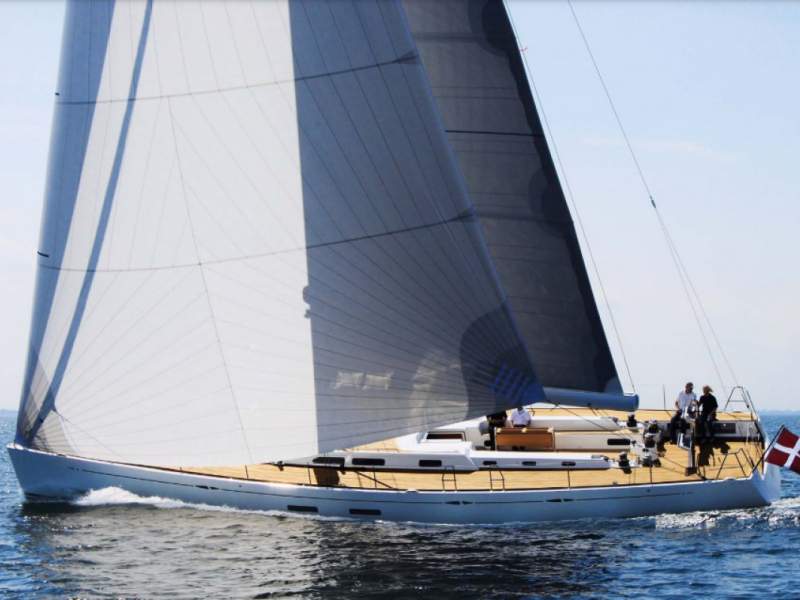

- My Searches
- Watch List (0)
- Sign In
Used Boats For Sale
Trailer boats - power, bullet boats for sale, bullet 5.60 stinger boats for sale, bullet 5.60 stinger just listed.
ABOUT THE SELLER

CONTACT THE SELLER


11 Small Boats With Cabins You Can Afford (With Pictures)
If you’re looking for a small boat with a cabin, what you’re essentially looking for is either a trawler, a cuddy cabin, or a “cruiser”.
Let’s break down each category and find some great deals for each.
Table of Contents
After we’ve gone over these categories, we’ll also go over a few questions which need to be answered before you decide on a purchase.
What is the most affordable cabin cruiser or a small cabin boat?
There are a variety of cuddy cabins which are both affordable and spunky while out on the water.
You can find older models for sale between $20,000 and $30,000, and which are between 20’ and 25’ in length.
Some of the best options you can find are:
- 20’ Pro-Line Hard Top
- 22’ Sea Hunt 225 Victory
- Sea Ray Sundeck
- Stingray 21’ Cuddy Cabins
What is the best trawling boat?
While you might not be a fisherman at heart, some of the heartiest boats are fishing boats. They have bigger cabins for fisherman to relax after a hard day on the water as well as large storage areas for their gear.
Trawling is a method of fishing where the fisherman drags a net through the water behind them.
Recreational trawlers aren’t actually fishing boats, however. They resemble the vessel’s design, but that’s where the similarities end.
Remember that recreational trawlers use smaller engines than their fishing brethren; one which will only produce approximately 80 hp.
Trawlers have a dedicated following. These boats can be slow cruisers but, at their heart, they weren’t built for speed. After all, they are single-engine boats that can go from 7 knots to 20 knots.
One of the best values when it comes to trawling boats is the Carver c34 .
Here it is:

While it might not be as inexpensive as the other options in this article, at $371,820, you’re getting a smaller (34 feet long) more economical coastal cruiser.
More economical than a lot of the other boats of the same type on the market right now, which can range up to $500,000 – $900,000(!)
If you look for this boat used, you will most likely find it over $100,000 cheaper than the new sticker price.
What is the best boat to buy for a beginner?
The Glastron GS 259 is a 25-foot-long cruiser with a price range of about $77,000.

While the cabin is huge, as is the full galley, and the large dinette, the price also matches the large accommodations.
However, it will be difficult to find such accommodations on a boat of this size. Not only that, it comes recommended for a beginning boater by Lenny Rudow of Boats.com.
You should also check out the Trailcraft boat models .
What is the best cabin cruiser under 30 feet?
At 28 feet, the Bayliner 285 SB is a great cruiser which is still small enough to be towed and stored on your property.

But at the same time, it is still big enough to say overnight if you feel like going on a weekend excursion on your boat.
The price ranges from $96,000.
What is the best cabin cruiser under 25 feet?
A cabin cruiser is a powerboat with overnight accommodations and a galley.
They are generally faster than trawlers and cuddy cabins and can range from 25’ to 100’ in length. There are a number of different types of cruisers, including:
- Aft cabin cruisers
- Convertibles
- Express cruisers
- Motor yachts
- Pocket cruiser
It cuts it close, but the Cutwater 242 Sport Coupe is just over 25’ (at 26’) and can be found for around $100,000.

It also comes in a longer 10’ model and has a double-stepped hull with a deep entry that turns into a moderate keel pad, which shows off its maximum efficiency.
It even has the option of coming with an electric grill built into the transom, and an adjacent sink.
The former is fully removable and can hide under a fully rigged livewell.
All of these small touches add to its appeal.
What if I don’t necessarily need a cabin?
If not having a cabin isn’t a deal breaker, your options for affordable boats just blew wide open:
The 16’2” Bayliner Element
($14,742) with a cruising speed in the mid 20’s can seat four.
The 17’11” Four Winns H180 OB
($24,451) includes a swing away tongue, full-sized walk-across swim platform, and Bluetooth-capable stereo with MP3 port and two speakers.
The 23’1” Larson LX 225S IO
($43,267) comes with a trailer that has disc brakes, a canvas bow, and cockpit covers. It also has an MP3-capable stereo.
Is it better to buy a used boat?
There are plenty of advantages to buying a used boat. The biggest advantage is the price.
While you might find some expensive boats listed on used vessel or vehicle websites, but you will find more reasonably priced used models than not.
Just like a car, a boat depreciates in value when it gets driven off of the lot.
Because of that, a used boat will better hold its value.
Another perk to buying used is the option to buy from a private seller or a dealer.
While there are many different perks, there are also a few disadvantages. One of which is that you never really know what you’re going to end up with.
You might be able to take it out for a ride with the seller but if you don’t have a boat mechanic look at it, you won’t really know what kind of wear and tear it’s been through.
If you do buy a boat used, make sure to inspect:
- The hull for scratches, dents, and marring
- The motor for damage
- The upholstery for worn spots and tears in the vinyl
- Broken levers
Don’t be shy about inspecting as much as you can.

An example of how to save money with a used boat is with the C Dory 23’ Venture Sport which weighs less than 3000 lbs. and has a fuel capacity of 60 gallons.
Fishermen will love how it tracks while you’re trolling, which will let you focus on fishing.
Every day boaters will love how much headroom is in the cabin and how much more pleasant it is to cruise on rough waters.
When you buy it new, it can be upwards to $100,000 but buying it used, instantly cuts the price in half or even as low as $35,000.
If you decide to find yourself a used boat, it would be best to check out some local options.
When is it better to buy a new boat?
A new boat ensures that you’re getting what you want.
The ability for customization is fantastic. From the paint scheme to the engine and turbines to the stereo system, you can fulfill your wish list in one stop.
New boats are both shiny and clean. You’ll rarely have any issues with the engine. You might also have the backing of a manufacturer’s warranty, which isn’t just a great deal of safety when it comes to your finances (in the long run) but is also great peace of mind.
The downside to buying a new boat is the price.
You’ll also have to deal with the depreciation, which starts as soon as you tow it off the lot. While it might cost a little more, look for high quality, trustworthy manufacturers and builders, which could help with the depreciation.
What exactly is a cuddy cabin on a boat?
A cuddy is another term for a small room on a boat. It comes from the 19 th century when they used to be referred to as saloon cabins, which were on the stern of ships.
These days it refers to a small shelter cabin , which has a small berth and head.
Normally, they are not tall enough to stand in but are still popular recreation boats for boaters who don’t quite want to upgrade to a full-size cabin boat.
A lot of fishermen use cuddy boats as their fishing boats because of the price, storage capabilities, and the small stature.
Final Thoughts
When going on a treasure hunt for your future boat, make sure that you have these things before you leave the house:
- An idea of what you are going to use your boat for (watersports, racing, fishing, day trips, cruising, party boat, etc.)
- An initial list of dreamboats you want to test out
- Clear cut boundaries for price and options (AKA a “wish list”)
Remember that it may take a little while to find your dream boat.
It can be difficult to cull through all of the choices at the lots or on the internet. Know that the only way to make sure which boat is perfect for you is to take it out for a spin on the water.
If you’re still indecisive, that just means that you can go out and try out as many different boats as you can. This search doesn’t have to be a chore; go out and have fun.
Click to share...

- Freizeit, Haus & Garten
- Haus & Haushalt
Diesen Artikel kostenfrei zurücksenden
Für die von dir gewählte Lieferadresse sind kostenlose Rücksendungen verfügbar. Du kannst den Artikel aus einem beliebigen Grund in neuem und unbenutztem Zustand zurücksenden: keine Versandkosten.
- Gehe zu deinen Bestellungen und starte die Rücksendung
- Wähle die Rücksendemethode

Lade die kostenlose Kindle-App herunter und lese deine Kindle-Bücher sofort auf deinem Smartphone, Tablet oder Computer – kein Kindle-Gerät erforderlich .
Mit Kindle für Web kannst du sofort in deinem Browser lesen.
Scanne den folgenden Code mit deiner Mobiltelefonkamera und lade die Kindle-App herunter.

Bild nicht verfügbar

- Herunterladen, um dieses Videos wiederzugeben Flash Player
- 360°-ANSICHT
Mini Yacht 5.6: Bauanleitung Taschenbuch – 28. August 2020
Kaufoptionen und Plus-Produkte
- Seitenzahl der Print-Ausgabe 84 Seiten
- Sprache Deutsch
- Herausgeber tredition
- Erscheinungstermin 28. August 2020
- Abmessungen 12.7 x 0.46 x 20.32 cm
- ISBN-10 3347125592
- ISBN-13 978-3347125599
- Alle Details anzeigen
Wird oft zusammen gekauft

Kunden, die diesen Artikel angesehen haben, haben auch angesehen

Produktbeschreibungen
Über den autor und weitere mitwirkende, produktinformation.
- Herausgeber : tredition; 1. Edition (28. August 2020)
- Sprache : Deutsch
- Taschenbuch : 84 Seiten
- ISBN-10 : 3347125592
- ISBN-13 : 978-3347125599
- Abmessungen : 12.7 x 0.46 x 20.32 cm
- Nr. 469 in Bau, Ausbau & Renovierung (Bücher)
- Nr. 20.578 in Sport Allgemein
Kundenrezensionen
- 5 Sterne 4 Sterne 3 Sterne 2 Sterne 1 Stern 5 Sterne 72% 28% 0% 0% 0% 72%
- 5 Sterne 4 Sterne 3 Sterne 2 Sterne 1 Stern 4 Sterne 72% 28% 0% 0% 0% 28%
- 5 Sterne 4 Sterne 3 Sterne 2 Sterne 1 Stern 3 Sterne 72% 28% 0% 0% 0% 0%
- 5 Sterne 4 Sterne 3 Sterne 2 Sterne 1 Stern 2 Sterne 72% 28% 0% 0% 0% 0%
- 5 Sterne 4 Sterne 3 Sterne 2 Sterne 1 Stern 1 Stern 72% 28% 0% 0% 0% 0%
Kundenbewertungen, einschließlich Produkt-Sternebewertungen, helfen Kunden, mehr über das Produkt zu erfahren und zu entscheiden, ob es das richtige Produkt für sie ist.
Um die Gesamtbewertung der Sterne und die prozentuale Aufschlüsselung nach Sternen zu berechnen, verwenden wir keinen einfachen Durchschnitt. Stattdessen berücksichtigt unser System beispielsweise, wie aktuell eine Bewertung ist und ob der Prüfer den Artikel bei Amazon gekauft hat. Es wurden auch Bewertungen analysiert, um die Vertrauenswürdigkeit zu überprüfen.
Keine Kundenrezensionen
- Karriere bei Amazon
- Pressemitteilungen
- Erfahre mehr über Amazon
- Amazon Science
- Jetzt verkaufen
- Verkaufen bei Amazon Business
- Verkaufen bei Amazon Handmade
- Partnerprogramm
- Versand durch Amazon
- An Amazon liefern
- Deine Marke aufbauen und schützen
- Prime durch Verkäufer
- Bewerbe deine Produkte
- Dein Buch mit uns veröffentlichen
- Hosten eines Amazon Hubs
- › Mehr von „Mit uns Geld verdienen“ anzeigen
- Amazon Visa
- Einkaufen mit Punkten
- Finanzierung von Barclays
- Amazon Business Amex Card
- Monatsabrechnung
- Amazon-Währungsumrechner
- Mein Amazon-Konto aufladen
- Amazon vor Ort aufladen
- Amazon und COVID-19
- Lieferung verfolgen oder Bestellung anzeigen
- Versand & Verfügbarkeit
- Amazon Prime
- Rückgabe & Ersatz
- Recycling (einschließlich Entsorgung von Elektro- & Elektronikaltgeräten)
- Verträge kündigen
- Vodafone-Verträge kündigen
- Meine Inhalte und Geräte
- Rückrufe und Warnmeldungen zur Produktsicherheit
- Kundenservice
- Barrierefreiheit
- Wunschzettel
- Illegalen Inhalt melden
| Hörbücher herunterladen | ||||||||||
- Datenschutzerklärung
- Hinweise zu Cookies
- Hinweise zu interessenbasierter Werbung
- Merkzettel 0
- Warenkorb 0
- alle Medien
- Medical Equipment

Mini Yacht 5.6
Rolf urbansky (autor).
- Versand in 10-15 Tagen
- Versandkostenfrei innerhalb Deutschlands
- Auch auf Rechnung
- Verfügbarkeit in der Filiale vor Ort prüfen
- Artikel merken
- Produkt-Details
Rolf Urbansky wurde 1941 in Potsdam geboren und wuchs in Wolfenbüttel auf. Vom aktiven Schwimmsport in der Jugendzeit wechselte er mit 18 Jahren zum Segelsport. Das Lasersegeln war der Anfang, es folgte das P-Boot und zum jetzigen Zeitpunkt wird die S-500 Yacht gesegelt. Parallel zum Wassersegeln begann Rolf Urbansky mit dem Eis- und Strandsegeln. Er nahm in den Strandsegelklassen 3 und 5 an Deutschen, Europa- und Weltmeisterschaften teil. Sein Sohn und seine Ehefrau teilen dieses Hobby und nahmen ebenfalls an diesen Wettfahrten teil. In der Klasse 5 baute Herr Urbansky seine Segelwagen alle selbst. Dies veranlasste ihn auch in der Mini Yachtklasse einen eigenen Wagen zu bauen. Nach Beendigung des aktiven Wettfahrtsegelns wird das Wasser- und Strandsegeln weiterhin mit viel Spaß ausgeübt.
| Erscheinungsdatum | 29.08.2020 |
|---|---|
| Sprache | |
| Maße | 120 x 190 mm |
| Gewicht | 98 g |
| Themenwelt | ► ► |
| Schlagworte | Bauanleitungen • Bauanleitung Strandsegler • BauanleitungStrandsegler • Landsegler bauen • Landseglerbauen • Meer • Mini Yacht 5.6 • MiniYacht5.6 • Segeln • Strand • Strandsegeln • Strandsegler bauen • Strandseglerbauen |
| ISBN-10 | 3-347-12559-2 / 3347125592 |
| ISBN-13 | 978-3-347-12559-9 / 9783347125599 |
| Zustand | Neuware |

von Thomas Königstein

von Martina Goernemann

von Christine Spörri
- Hausbau / Einrichten / Renovieren
- AGB / Widerrufsbelehrung
- Datenschutzerklärung
- Versandkosten
- Rechnung herunterladen
- Rechnung bezahlen
- Erweiterte Suche
- Unsere Filialen
- Menschen bei Lehmanns
- Jobs bei Lehmanns
- PremiumCard
- Veranstaltungen
- Bibliotheken
- Krankenhäuser
- Rechtsanwälte
- Wirtschaftsprüfer
- Unternehmen
- Öffentliche Hand
- Open Access

IMAGES
COMMENTS
The US International 5.6 Mini Association is dedicated to promoting sailing and racing of International 5.6 mini yachts in the United States. Our intentions are to continue to grow the Intl. 5.6 class. We have created a temporary committee of 5 to handle current and future decisions for the US International 5.6 mini class. There may be a need for decisions at races, i.e. race course, rolling ...
This makes the structure lighter and at the same time improves its stiffness. She is an innovative boat in shape and materials, ready for ocean sailing in the Mini 6.50 Class Sailplan 26 mq - Gennaker 37,5 mq - Code 5 79 mq - Spinnaker Maxi 60 mq - Spinnaker medio 4 mq - Storm jib 25 mq - Main sail 19,5 mq - Jib.
Appendix: 5.6 Mini Yacht Rules, courtesy of FISLY. A mini yacht is: Any assembled land or sand yacht that fits inside a continuous loop of rope 5.6 metres long. The rope must lie on the ground. The touching part of the tyres on the ground must fit inside the rope. The tyre size is maximum 400x8. The mast must be a circular tube; no wing section ...
The Scow-bowed Mini racer. The Vector 6.5 is the latest generation series production Classe Mini 6.50 racer. The boat has been designed by Frenchman Etienne Bertrand in 2017, entering that year´s edition of the Mini Transat race as a prototype, finishing off at an impressive second place. The boat displays latest downwind running optimized ...
The Didi - a radius chine plywood Mini 6.5 you can build yourself. Mini 6.5 or Mini-Transat boats attract great interest worldwide. Tiny but costly offshore yachts, they give spectacular sailing, but are generally beyond the ability of most amateur builders. The Didi Mini was commissioned by a client who wanted to build a Mini for himself and ...
The US mini thing happened a long time ago. The latest 5.6 Us mini rules came shortly after the last America's Landsailing Cup in March. I think they beat most to the punch with the change. The 5.6 US mini rules will likely adopt the International rules when they come out.
This offers the possibility of yachts with long wheelbases and narrow tracks or just the opposite, and everything in between. Interestingly, the rules do not specify how the 5.6 Mini races will start.
English & Spanish. International Miniyacht (5.60) Class Association A Group for anyone interested in land sailing in small landyachts known as Miniyachts, Kart a Voile, Class 5.60, 5.6m, Minis etc...
aus230. WA. 1659 posts. 22 Dec 2012 9:13AM. I think the 5.6 mini has been a great step forward for land sailing and common sense should prevail. It does away with all the restrictive rule's and replaces them with a little yacht that can be built well within the skills of a home builder.
5.6 Mini class land yachts bring rolling starts and large fleets to Worlds ...
New 2024 X-yachts X-5.6. The X5.6 is a new generation of performance cruisers - launched in 2021 the X5.6 has already surpassed our expectations and was...Find out more
A boat with a BN of 1.6 or greater is a boat that will be reefed often in offshore cruising. Derek Harvey, "Multihulls for Cruising and Racing", International Marine, Camden, Maine, 1991, states that a BN of 1 is generally accepted as the dividing line between so-called slow and fast multihulls.
The Mini 6.50 is the smallest ocean racing boat. Small but sturdy, the Mini 6.50 regularly crosses the Atlantic. It is a boat to learn and perform in double and single-handed sailing. It is the boat of the famous Mini Transat, a race on which almost all the greatest sailors used their oilskins at the beginning.
The class faded, and now the only truly active Mini 12 fleet is at the Seattle Yacht Club. The 2.4 Metre, on the other hand, has gone from success to success, gaining ISAF International Class status and finding a niche for both able-bodied and disabled sailors with large fleets in Scandinavia.
With the (pending) and (possible), 2017 FISLY 5.6 mini rule changes, The US 5.6 mini yacht association as desided to change our stance on the US 5.6 rules, We feel the need to open the US 5.6 class to all comercially built yachts, and for the sake of all the pilots who build and experiment and still would like to race their yachts with the other 5.6 minis..
Send to Friend. The X5.6 is a new generation of performance cruisers - launched in 2021 the X5.6 has already surpassed our expectations and was nominated as the European Yacht of the Year in 2022. The X5.6 has the performance to win races and the safety and comfort to provide fast cruising anywhere in the world.
Boat Details. Description. Light, strong and stiff. With the introduction of the X-65 in 2007, X-Yachts started to infuse hulls for performance yachts utilising epoxy resin. Epoxy infusion construction offers fantastic control over the laminate allowing it to be optimised to maximise strength and stiffness, whilst saving weight.
Select the department you want to search in ...
bullet boats 5.6 stinger cc !!! fishing weapon with so much room this boat is powered by a yamaha 130 hp 4 stroke outboard in great condition !!! also including a brand new lowrance hds12 pro, big strong aluminium t - top, gme stereo, radio, anchor winch, live well and more !!!
There are a variety of cuddy cabins which are both affordable and spunky while out on the water. You can find older models for sale between $20,000 and $30,000, and which are between 20' and 25' in length. Some of the best options you can find are: 20' Pro-Line Hard Top. 22' Sea Hunt 225 Victory. Sea Ray Sundeck.
Bauanleitungen für Strandsegler Mini Yacht 5.6. Es werden zwei Varianten für den Selbstbau der Mini Yacht 5.6 beschrieben. Materiallisten werden aufgelistet und einzelne Arbeitsschritte erklärt. Die geometrischen Einflüsse der Rahmen werden aufgezeigt, um den Einfluss auf die Fahreigenschaften der Mini Yacht zu verdeutlichen.
Mini Yacht 5.6: Bauanleitung Taschenbuch - 28. August 2020. von Rolf Urbansky (Autor) 4,7 8 Sternebewertungen. Alle Formate und Editionen anzeigen. Buchbeschreibung. Rezensionen der Redaktion. Bauanleitungen für Strandsegler Mini Yacht 5.6. Es werden zwei Varianten für den Selbstbau der Mini Yacht 5.6 beschrieben.
12,00 inkl. MwSt. Bauanleitungen für Strandsegler Mini Yacht 5.6. Es werden zwei Varianten für den Selbstbau der Mini Yacht 5.6 beschrieben. Materiallisten werden aufgelistet und einzelne Arbeitsschritte erklärt. Die geometrischen Einflüsse der Rahmen werden aufgezeigt, um den Einfluss auf die Fahreigenschaften der Mini Yacht zu verdeutlichen.